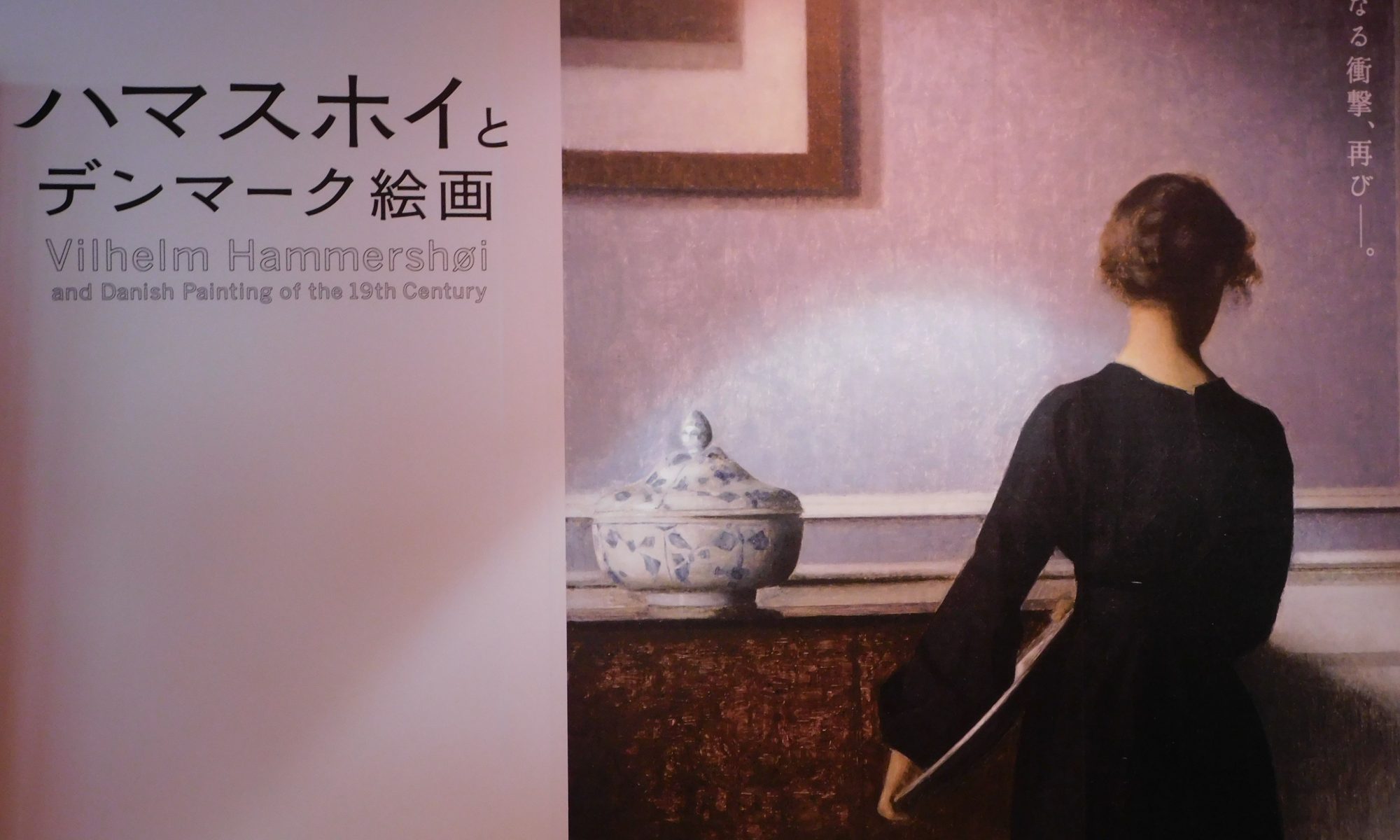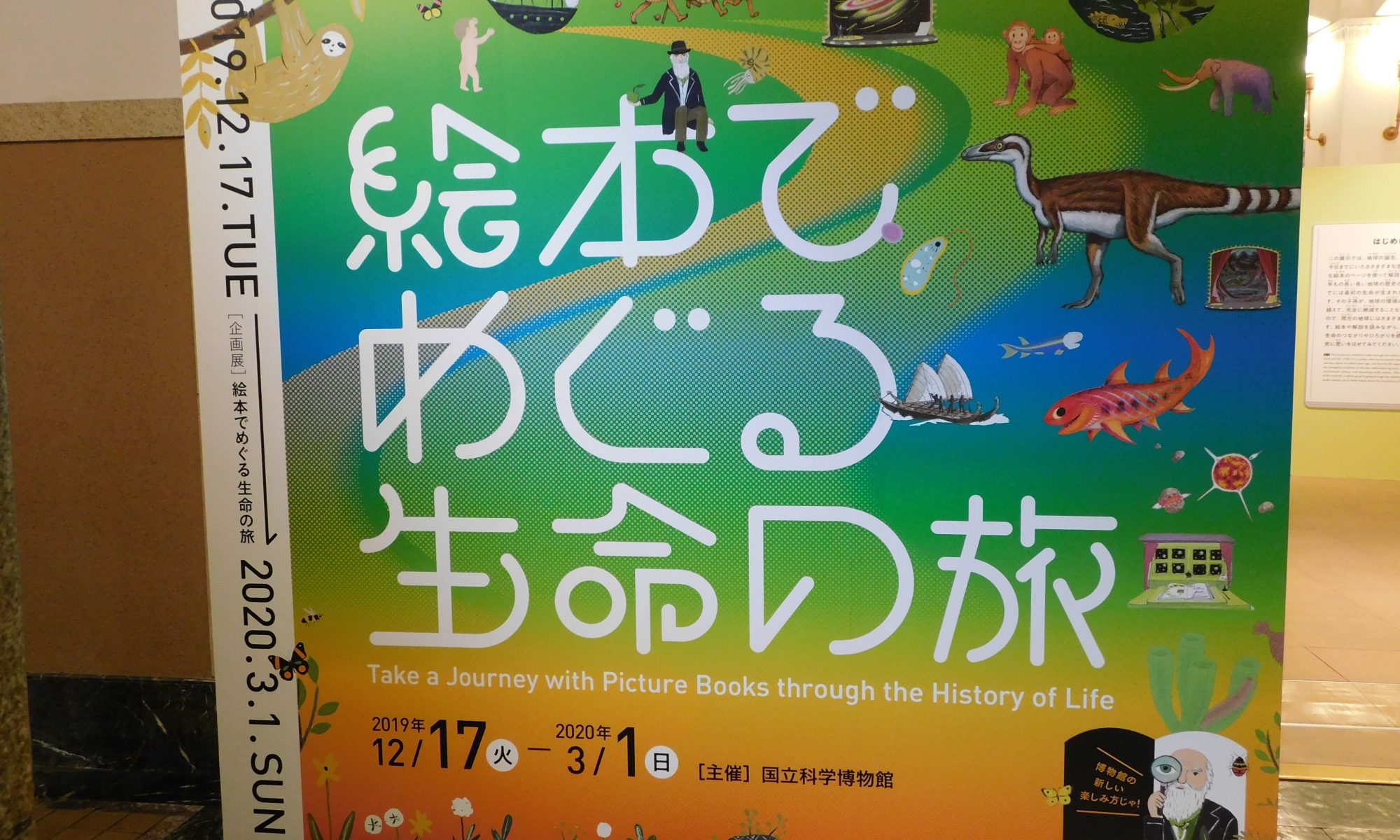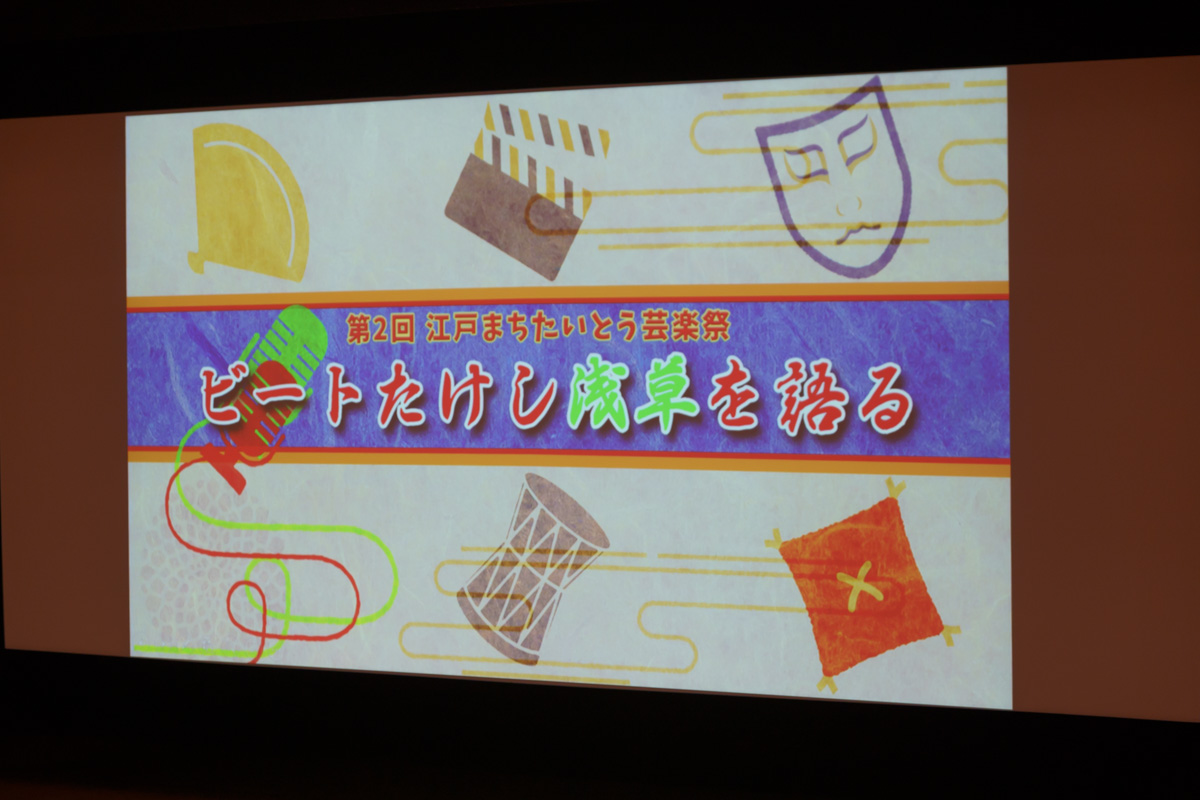Other areas of Ueno Onshi Park

The Ueno Bunka no Mori New Plan Executive Committee and the Tokyo Metropolitan Foundation for History and Culture Arts Council Tokyo will hold a two-day special concert “Culture Forest” on February 12 (Wed) and 13 (Thu), 2020. Sound Tour 2020 ”will be held.
「Cultural Forest Sound Tour 2020」 is a 6 cultural facility located in Ueno Park
Ueno Forest Museum ( http://www.ueno-mori.org/ ), Tokyo National Museum ( https://www.tnm.jp/ ), Former Tokyo Conservatory of Music ( http: //www.taitocity. net / zaidan / sougakudou / ), Tokyo Bunka Kaikan ( https://www.t-bunka.jp/en/ ), National Science Museum ( https://www.kahaku.go.jp/english/ ), Tokyo Metropolitan Art Museum ( https://www.tobikan.jp/en/index.html ), and different programs are prepared for special arrangements centered on the winners of the Tokyo Music Competition.
This event is a special concert where visitors can travel from the concert hall to the museum and from the museum to the museum as they call “Moto-Meguri”, and experience various cultures while listening to the performances. Each of the six venues will be visited three times a day, and each building in Ueno Park will be colored with wonderful performances.
The performers are composed of various organizations such as flute trio, string quartet, woodwind quartet, soprano & bass & guitar, piano solo. We provide extraordinary and special experiences for visitors to Ueno Park.
■ URL: https://uenoyes.ueno-bunka.jp/2019/en/2019/
■ Date and time: Wednesday, February 13 and Thursday, February 13, 2020 / 11:00-13:00-15:00-each day
■ Venue: Ueno Forest Museum, Tokyo National Museum, Former Tokyo Conservatory of Music, Tokyo Bunka Kaikan, National Science Museum, Tokyo Metropolitan Art Museum
* Depending on the venue, admission may be restricted if there are many visitors.
* In case of stormy weather, the content of the event may be changed or canceled. Also, the program, performers, etc. may be changed for convenience.
■ Fee: Free ※ However, admission fee is required for Tokyo National Museum, Former Tokyo Conservatory, and National Science Museum.
<Admission fee> Tokyo National Museum / General 620 yen, University students 410 yen, Former Tokyo College of Music / General 300 yen, Elementary, middle and high school students 100 yen, National Science Museum / General and university students 630 yen
★ You can enter the Tokyo National Museum and the National Science Museum with special exhibition tickets. Re-entry is possible only on the day.
(The Tokyo National Museum is the main gate plaza only on February 12, and the National Science Museum is general information only on February 13, and you can re-enter by presenting your stub on the day.)
■ Organizer: Ueno Bunka no Mori New Project Executive Committee, Tokyo Metropolitan Foundation for History and Culture Arts Council Tokyo
* This project is a project to create a base for transmitting international cultural arts to the Agency for Cultural Affairs in the first year of Reiwa.

● 11: 00-11: 20 / Flute Trio
Place: Ueno Forest Museum Entrance Lobby
Program: Kuhlau “Flute Trio in E minor, Op. 86 No. 1” and others
Performers: Yuri Ito, Kanako Hatakeyama, Airi Hosokawa (flute)
● 13: 00-13: 20 / String Quartet
Place: Tokyo National Museum Main Staircase
Music: Mozart “String Quartet No. 14 K.387 First Movement from” Spring “”
Performers: Tomotake Seki (violin), Aya Yamaguchi (violin), Shioko Nakamura (viola), Koichi Fujimori (cello)
● 15: 00 ~ 15: 30 / Piano solo
Place: Former Tokyo Music School Sogakudo 2nd floor music hall
Program: Bach-Hess “Lord, Joy of Man’s Desire” and others
Performers: Riko Fukagai (piano solo) ■ Thursday, February 13
● 11: 00-11: 30 / String Quartet
Place: Tokyo Bunka Kaikan, large hall foyer
Program: Britten “String Quartet No. 2 op.36”
Performers: Moenoka Kishimoto (violin), Shumasa Hayashi (violin), Kenshi Nagata (viola), Yoshiyuki Kanie (cello)
● 13: 00 ~ 13: 20 / Woodwind Quartet
Place: National Science Museum, Japanese Pavilion, 2nd Floor Auditorium
Program: Toru Takemitsu “From the Wave Bon”
Performers: Takuya Shinohara (Oboe), Kiriko Shimofutsu (Flute), Shin Sugiyama (Clarinet), Keishi Omori (Horn)
● 15: 00-15: 20 / Soprano & Bass & Guitar
Place: Tokyo Metropolitan Art Museum, Keitaro Sato Memorial Art Lounge
Song: Toru Takemitsu “Small Sky” and others
Performers: Saki Nakae (soprano), Kenichiro Himi (bass), Beni Igarashi (guitar)
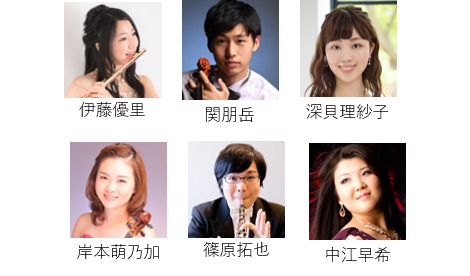
■ Date and time: Wednesday, February 12, 2020, Thursday, 13th, 10: 30-16: 00
■ Venue: Childcare room in the Tokyo National Museum Main Gate Plaza (13-9 Ueno Park, Taito-ku, Tokyo)
■ Target: 3 months or older-Preschool children
* Only for visitors to the “Cultural Forest Sound Tour 2020” and those who use various cultural facilities in Ueno Park.
■ Application: Advance reservation system, free of charge. * Please apply by phone.
■ Reservation: Asuka Co., Ltd. Special dial for reservation / 0120-165-115 (9: 00 ~ 18: 00 excluding weekends and holidays) ◆ Use “UENO WELCOME PASSPORT” to get around the sound
UENO WELCOME PASSPORT (sponsored by Ueno Bunka no Mori Initiative Executive Committee) will be able to enter the permanent exhibitions of museums and museums in the Ueno area and enter the Onshi Ueno Zoo once each time until March 31, 2020. It is a passport type common admission ticket. With this one book, you can fully enjoy “Cultural Forest Sound Tour 2020” and cultural facilities in the Ueno area. ■ 2,000 yen (tax included) only for permanent exhibitions ■ 3,000 yen (tax included) for one special exhibition ticket + permanent exhibition
* For details on sales locations, etc., see https://ueno-bunka.jp/ .◆ About Ueno Culture Forest
This is a new initiative for Ueno’s cultural facilities to work together to develop the potential of Ueno, a treasure trove of cultural resources. Proposed by the Agency for Cultural Affairs and promoting business in cooperation with Tokyo and Taito Ward.
Ueno Bunka no Mori New Plan Executive Committee [abbreviation: Ueno Bunka no Mori]
Tokyo National Museum / National Science Museum / National Museum of Western Art / Tokyo Metropolitan Art Museum / Tokyo Bunka Kaikan / Onshi Ueno Zoo / Ueno Forest Museum / Tokyo University of the Arts / Taito-ku / Ueno Tourism Federation / East Japan Railway Company / Keisei Electric Railway Co., Ltd. / Tokyo Subway Co., Ltd./Ueno Gakuen
Article provided by :Kokosil Ueno
【Tokyo Metropolitan Art Museum】 『Vilhelm Hammershøi and Danish Painting』 Press Preview Report
Tokyo Metropolitan Art Museum
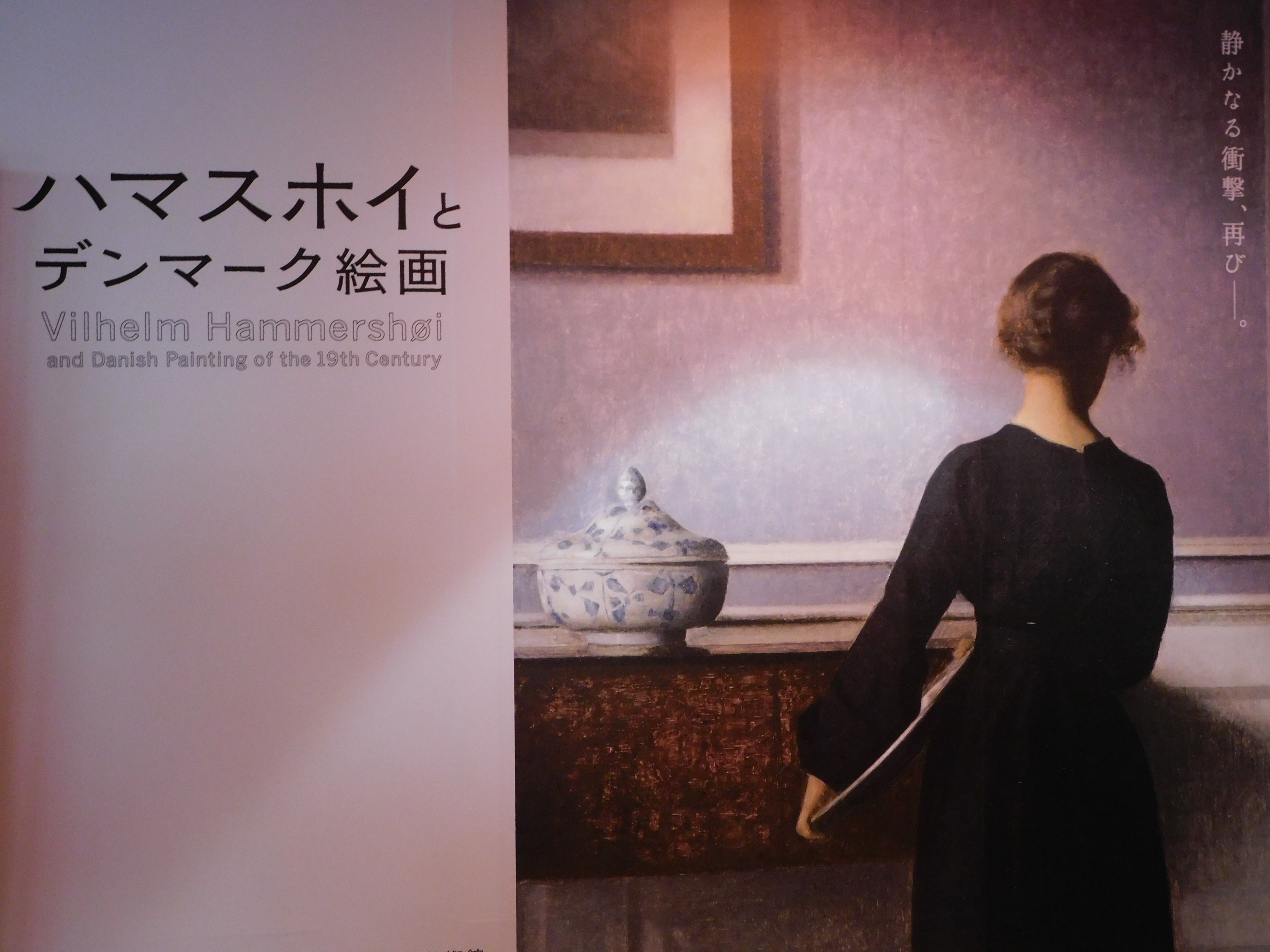
(Until Thursday, March 26, 2020) At the Tokyo Metropolitan Art Museum in Ueno, “Vilhelm Hammershøi and Danish Painting” is being held.
Prior to the event, there was a news preview the other day, so I will report on the situation.
Happiness Country / Denmark
Denmark is a constitutional monarchy in Northern Europe with a population of about 5.81 million.
The country name is derived from Dummelk, which means Old Norse (= Dane land), and is well known as a renewable energy advanced country and a high welfare state.
In recent years, their lifestyle has also attracted a great deal of attention, including being ranked number one in the United Nations’ World Happiness Rankings.
In relation to Japan, we celebrated the 150th anniversary of diplomatic relations in 2017.
The exhibition introduces some of the works of Denmark’s Wilhelm Hamashuy (1864-1916) and the surrounding works of Nordic art.
“Northern Vermeer” Hammershøi
Vilhelm Hammershøi (1864-1916), one of the leading painters of Danish painting in the late 19th century.
Hamashui begins drawing lessons at the age of eight.
After studying painting at the Royal Academy of Fine Arts in Copenhagen, Denmark, at the age of 15, he made his debut in “Portrait of Sister Ana” (1885) at the age of 21.
In the early days, I liked landscape paintings and portraits in the early days, but since the 1890s I have been drawing a lot of indoor paintings.
Strangerse 30 in the old town of Copenhagen, who moved when he was 34 in 1898.
A series of quiet and calm works depicting the apartment have won high acclaim both in and outside Denmark.
The work attracted Diagilehu of ballet Ruth and Rilke, a German poet.
It was called “Northern Vermeer” and attracted attention.
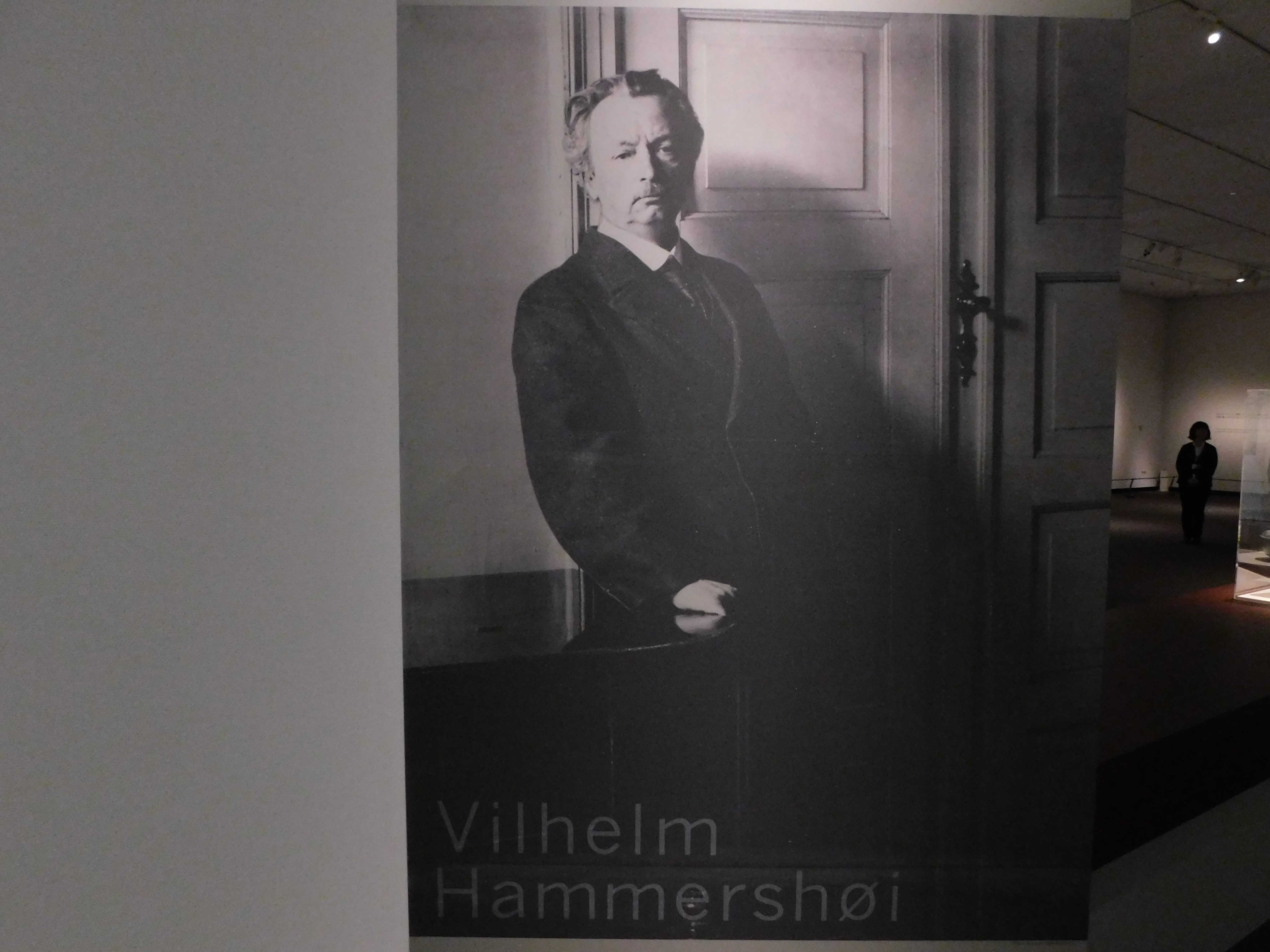
Highlight
There are four highlights of the Hamashui and Danish painting exhibition.
① About 40 Hammershøi works will be gathered
Approximately 40 Hammershøi works, including the first in Japan, will be gathered at the Tokyo Metropolitan Art Museum.
More than 10 years after the 2008 exhibition, Hammershøi works, also called “Northern Vermeer”, will return to Japan.
Please enjoy one side of that unique talent.
② Japan’s first authentic Danish painting exhibition
The golden age of Danish painting, which opened in the early 19th century in Copenhagen, the center of Nordic art.
From pure and rustic works of that era to beautiful Skain works incorporating the impressionist-style depiction of light, and the works of painters who worked in the capitals of the end of the century, who paint characteristic interior paintings. to introduce.
③Experience the Danish culture “Hyge”
Hygge means “relaxing” and “comfortable atmosphere” and is a very important Danish value.
It is the highlight of the exhibition that you can touch the Danish values.
The work of Danish painters in the late 19th century draws on Hyge, the beautiful Nordic nature, the people who live there, and the families who spend their time in a calm space.
By touching the Hughes in the works, you will be reminded of what we really want to value in life.
Featured works!
Here are some of the highlights from each chapter.
Chapter 1 Daily Praise-The Golden Age of Danish Paintings Featured Works
『A girl with a fruit basket』
A work by Constantine Hansun, son of Hans Hanson, a portrait painter.
This work is also famous for being later owned by Hamashui, and it seems that it was displayed on Strangese 25, where he spent his later years.
Is the whole work emitting a strong light, despite its subdued colors, due to the strength of the girl’s gaze looking straight at it?
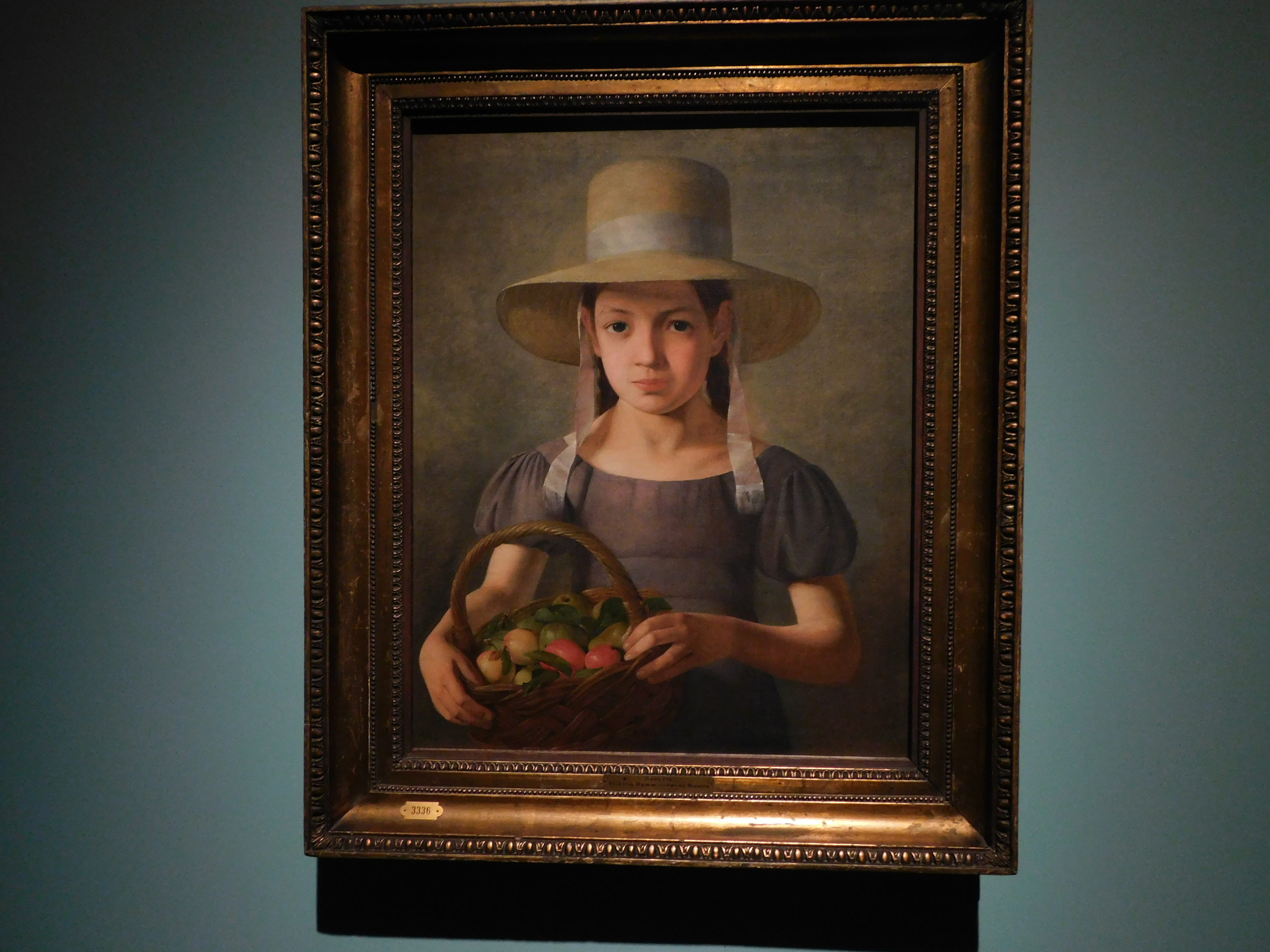
『Portrait of Fredereghe Laffenbaer (née Heylop)』
Wilhelm Maastran was born in Copenhagen and studied at the Royal Academy of Fine Arts, depicting the wife of Michelle Lafenbär, a prominent Danish tax official.
Rafenbea’s wife, stretching her back and staring straight at me.
Its elegant appearance is a mixture of strength and tenderness.
St. Peter’s Basilica, which can be seen outside the window, also enhances this work.
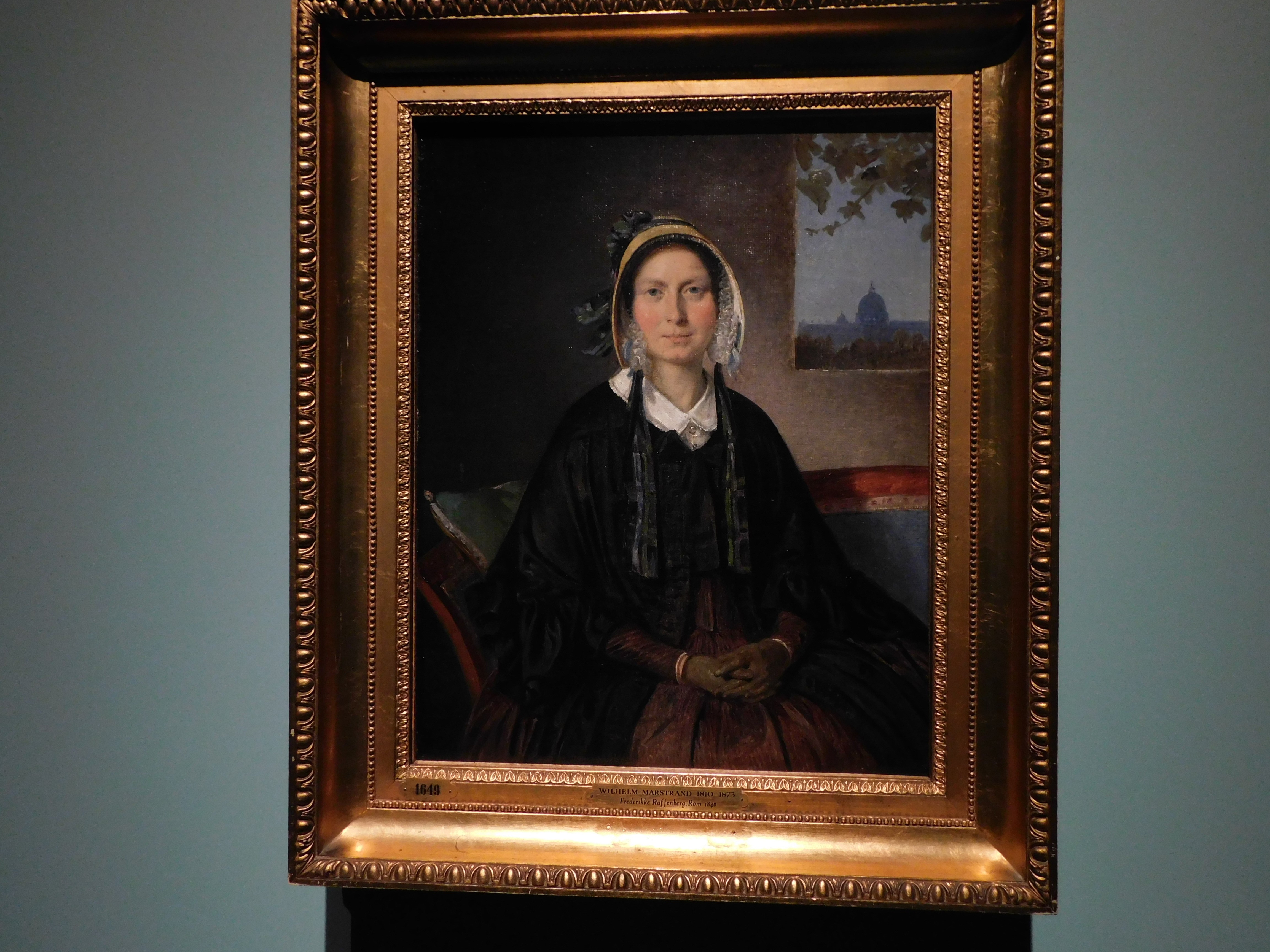
Chapter 2 Skein School and Scandinavian Light Featured Works
『Fishers rowing boats 』
A work by Michel Anga, famous as a painter representing Skain schools.
Fishermen in life jackets pushing a boat with a rugged look and going to the sea.
What is going on?
A tense situation ahead of the fishermen and the people watching it.
The intensity of the waves is increasing steadily.
It is a work with a sense of tension that is nervous and throbbing until you see it.
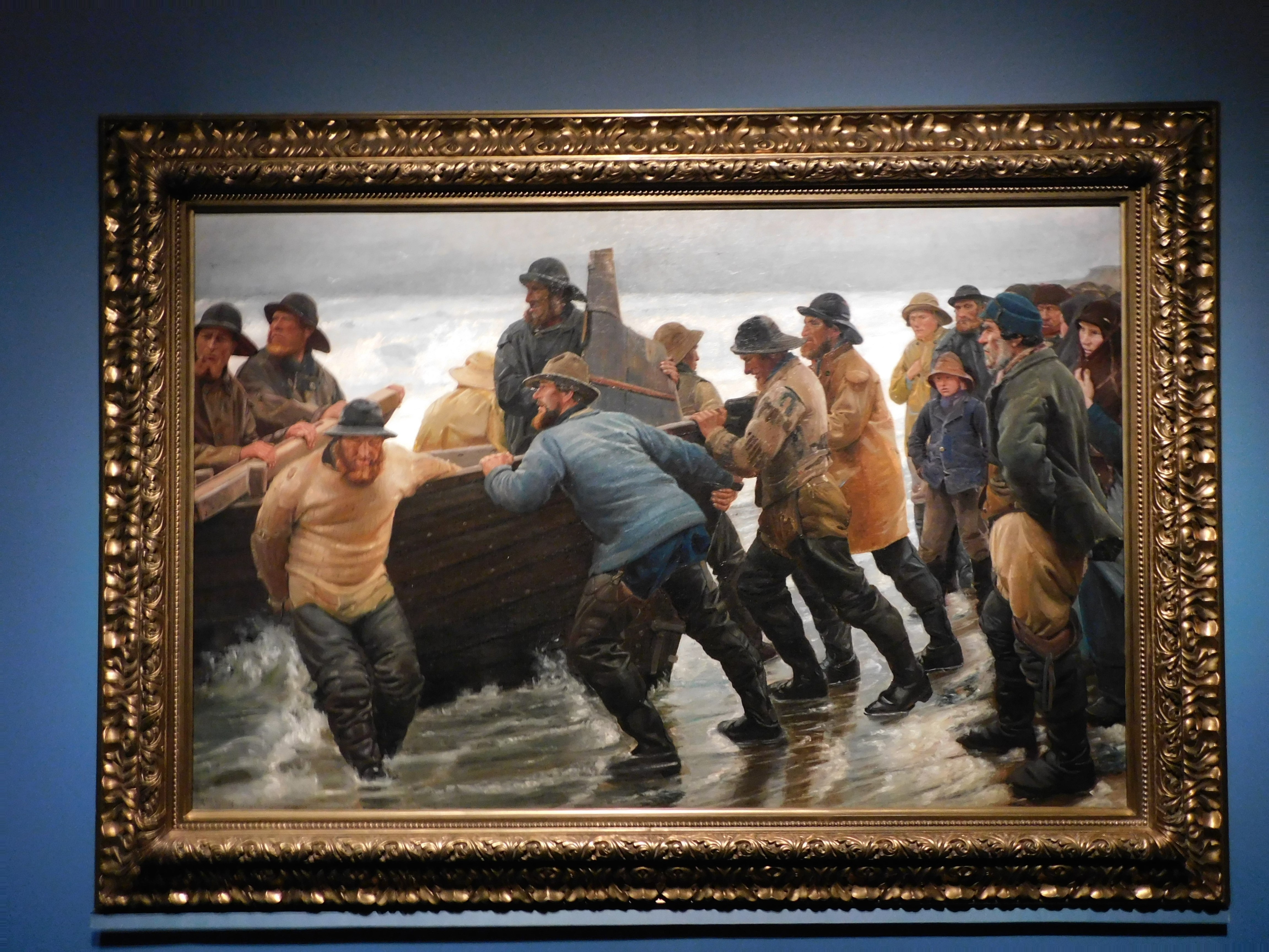
『 Girls and children picking flowers in the field north of Skain 』
This is also the work of Michel Anga.
Unlike the work depicting the tense situation of fishermen,
The meadow has a gentle time that lasts forever.
The girls picking flowers and their mother watching them under the everlasting blue sky.
The blue, pink, yellow, and greenery of the flowers are covered by a large sky.
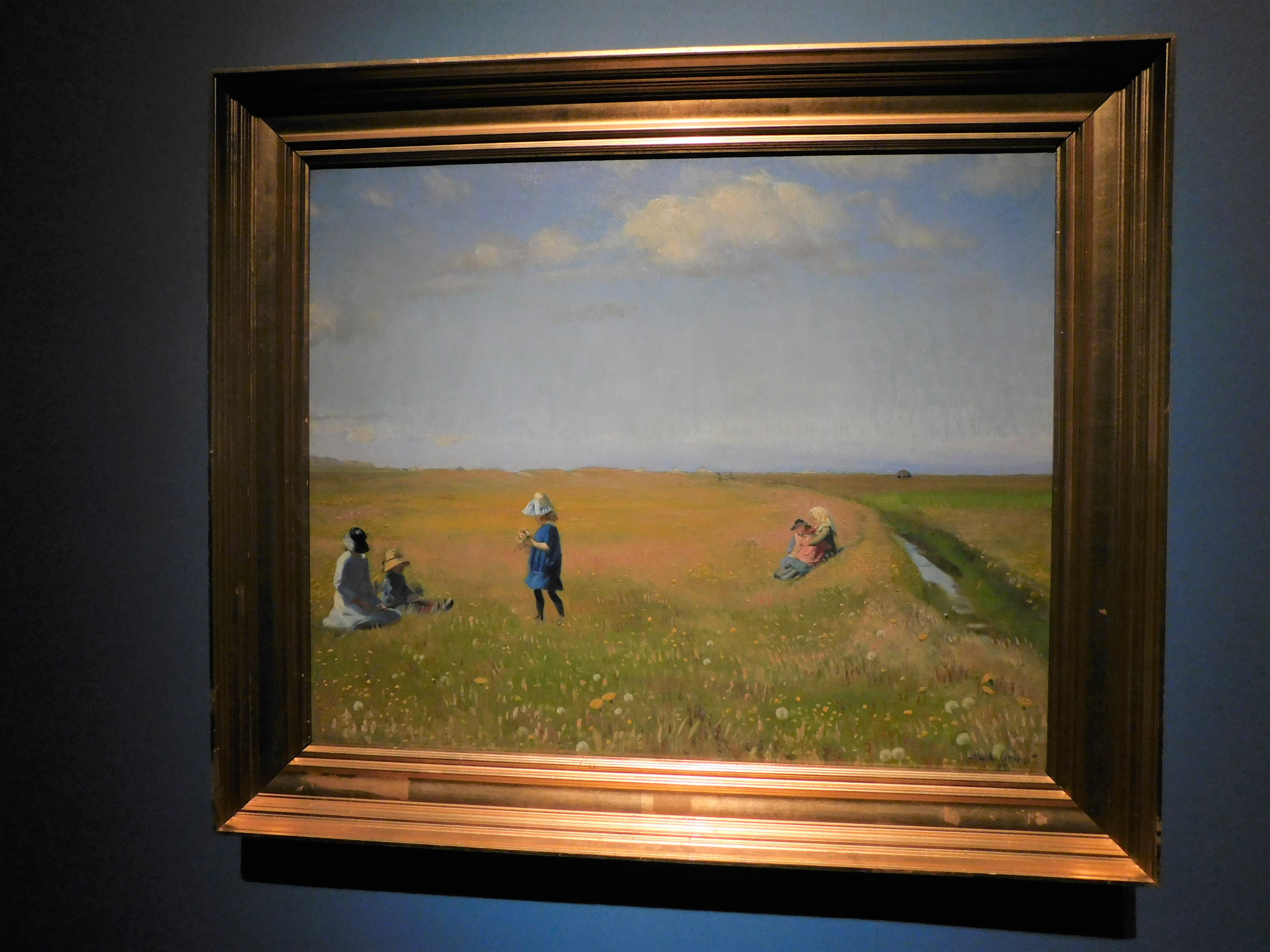
Skain Museum
Chapter 3 Danish paintings at the end of the 19th century-Internationalization and the rise of indoor paintings
『Sunshine in Living Room, Painter’s Wife and Child』
A work by Viggo Pedasson, whose father is Wilhelm Pedasson, an Andersen fairy tale illustration artist.
A work depicting Vigo’s wife, Ilisabeto, easing her little daughter in the living room at home.
The gentle face of his wife who cares for her daughter and the face of her young daughter who loves moms are very dear.
It seems that even the expression of Vigo, drawing while smiling, is transmitted here.
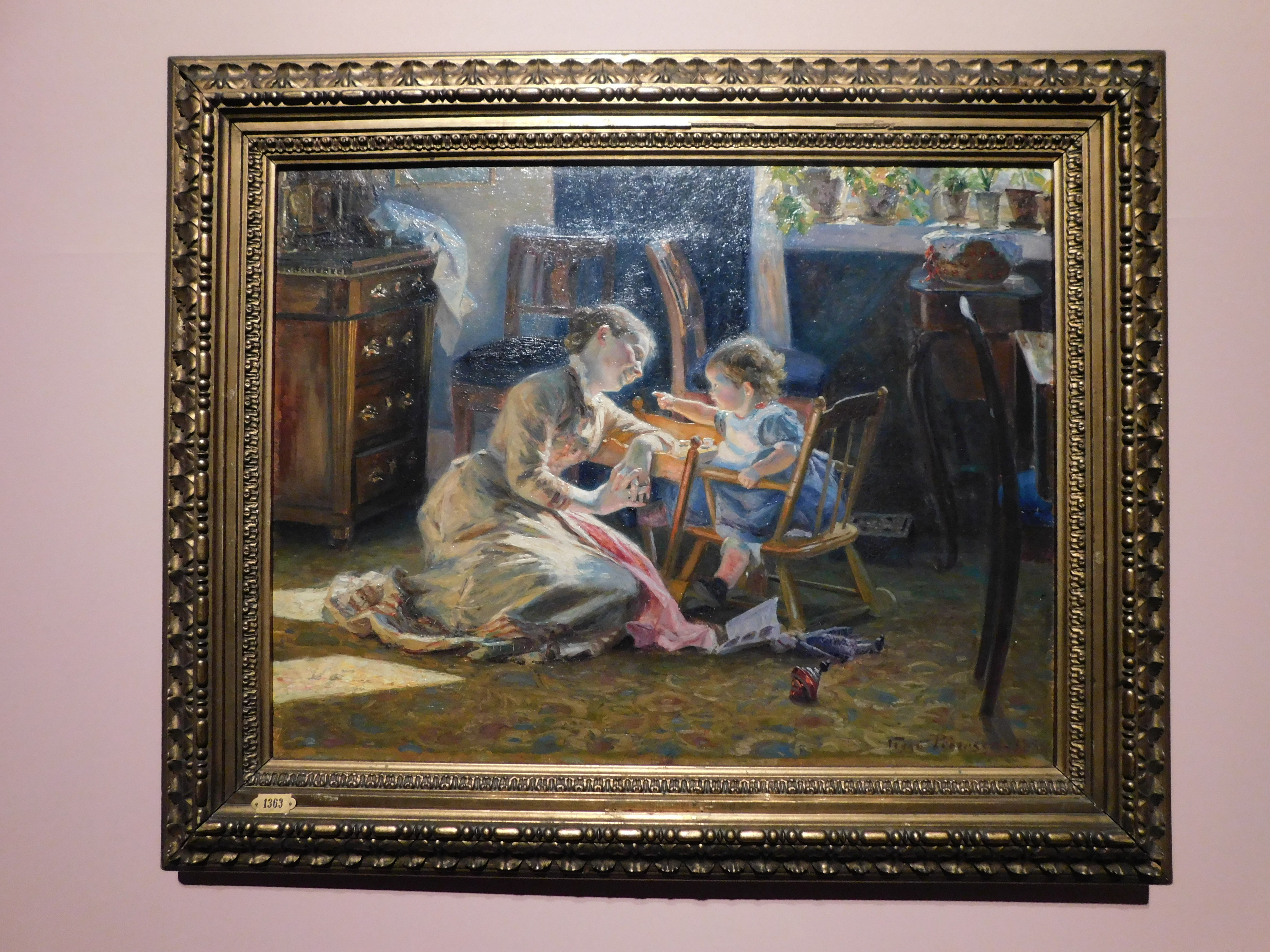
『Flower peach tree、Arles』
A work by Crestian Moaié-Pidasun, who has been in France, the Netherlands and Belgium, and is also famous for his friendship with Van Gogh in Arles.
The composition is very similar to Van Gogh’s “To Memories of Mauffet” and is believed to have been painted a few meters from where Van Gogh drew.
I was drawn into the gorgeous colors of the peach blossoms.
When approaching a little, the gentle scent of peach blossoms seems to be faintly transmitted.
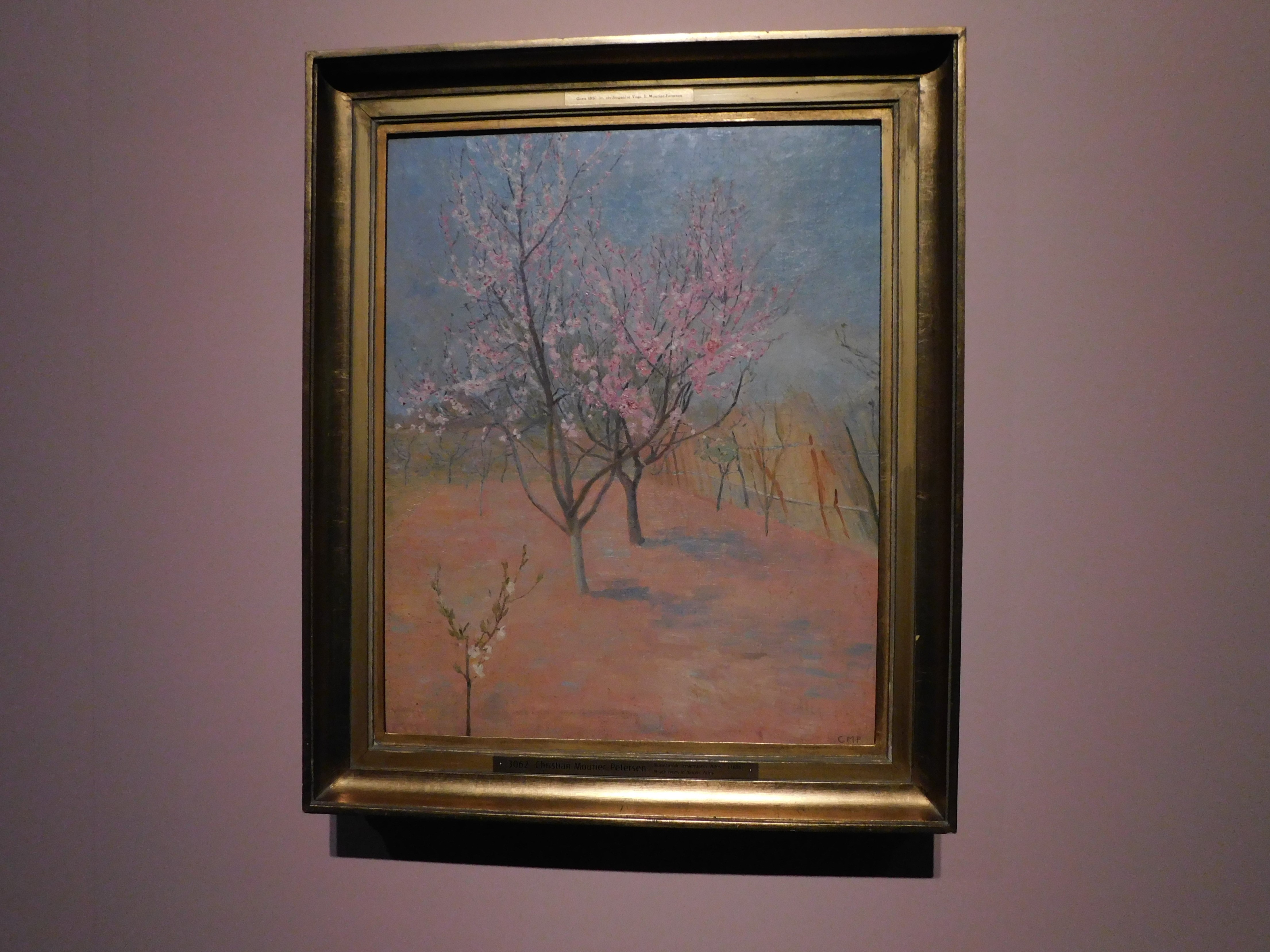
Chapter 4 Vilhelm Hammershøi-Featured Works in the Silence of the Capital
『Room-Sunshine Study, Strangese 30』
This is a work by Vilhelm Hammershøi depicting a room facing the courtyard of Strangese 30.
The light in the room coming through the elongated lattice window appears to drift steadily.
I imagine that if you open the window, the dazzling outside world is waiting.
The contrast between this bright outside world and the closed dark door is also exquisite.
Which is real and which is unreal?
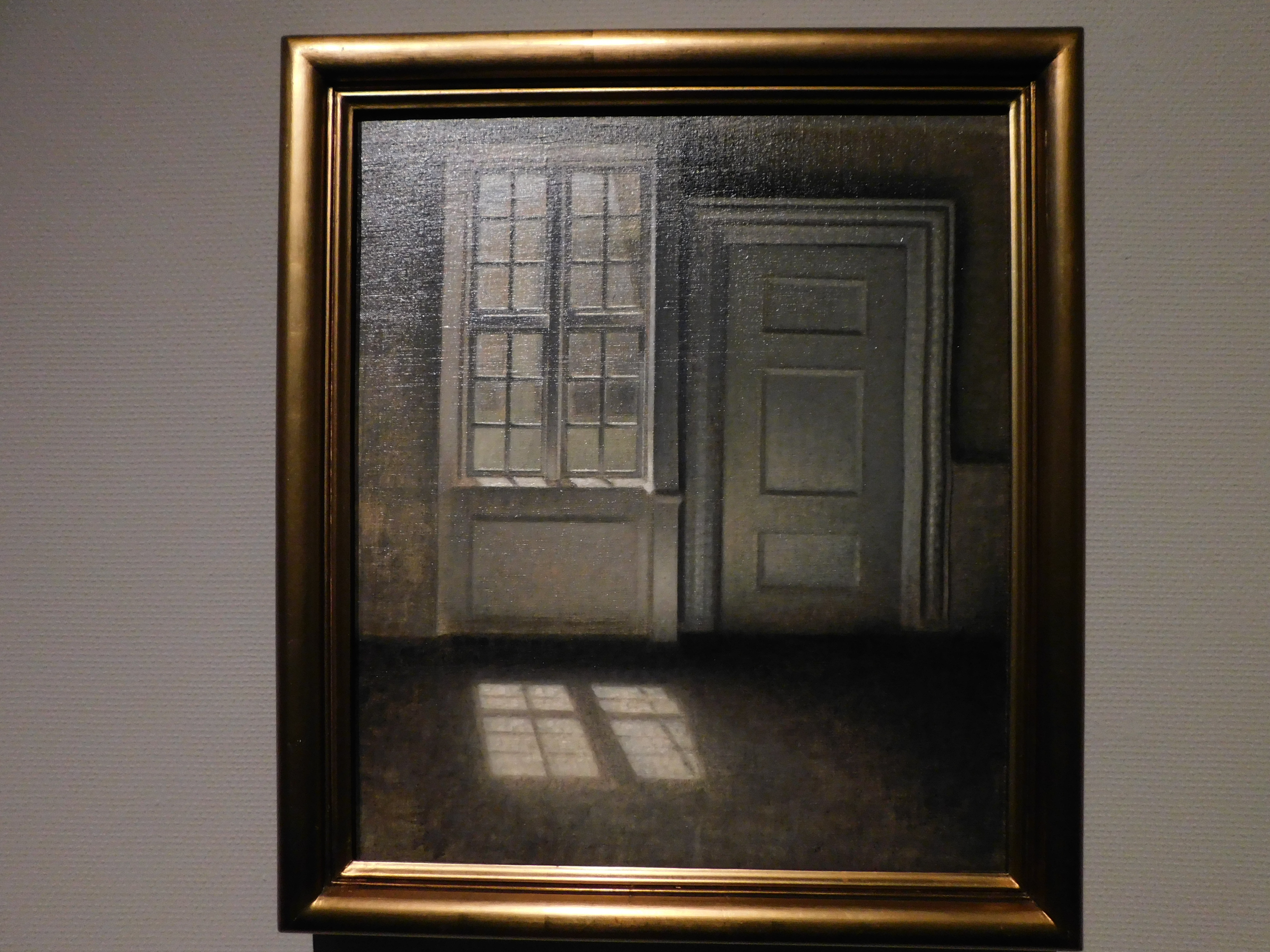
『Bedroom』
A work depicting the bedroom of Vilhelm Hammershøi of Labex Ali.
Two curtains hanging on the room
The light coming in from here is very soft.
Due to the light, the woman’s profile looking out of the window seems to be smiling somewhere. What are you looking at?
A purple vase placed in the center of the window tightens the interior painting.
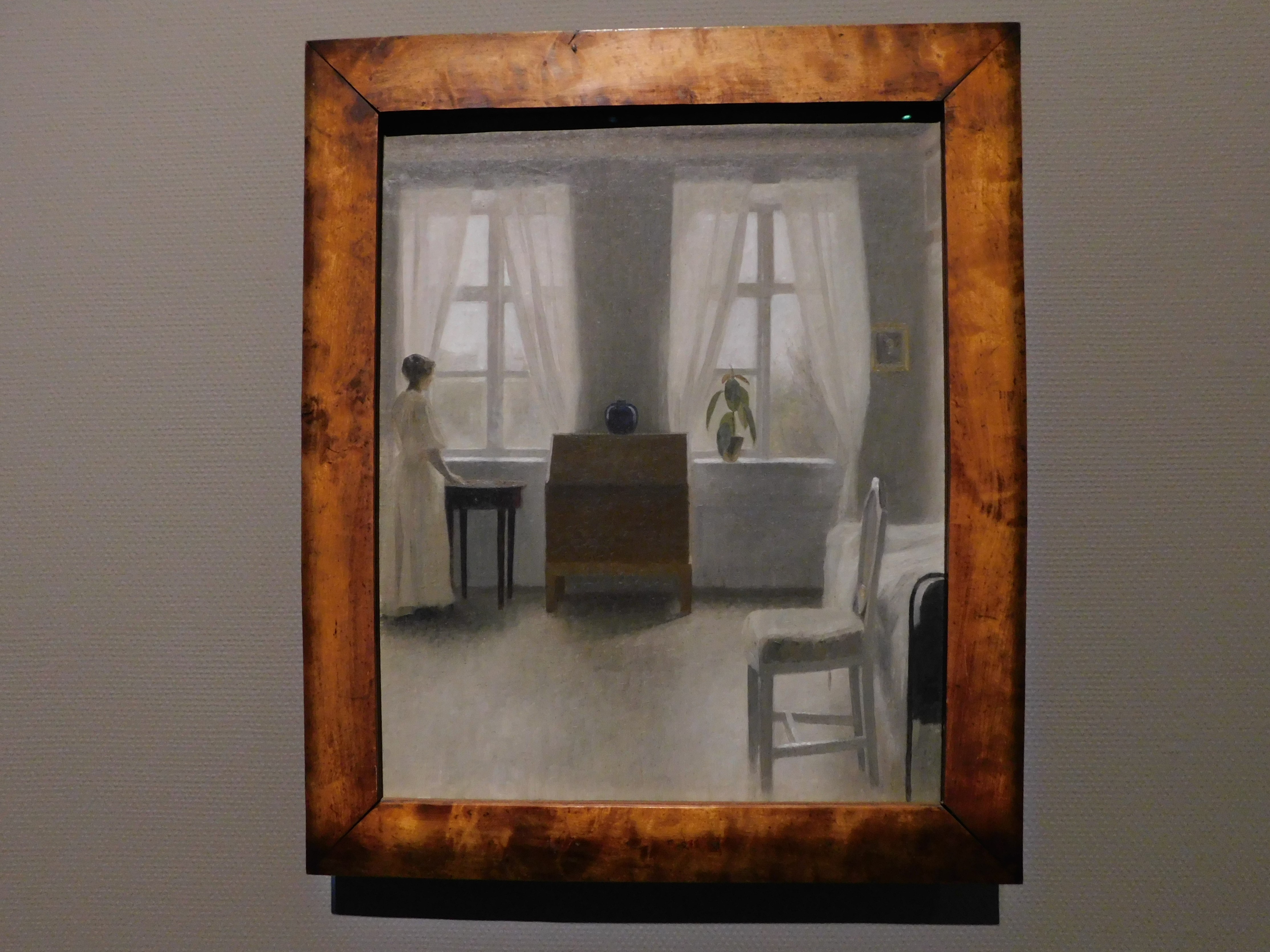
Conclusion
I have reported on the press preview of “Vilhelm Hammershøi and Danish Painting Press Preview Report”.
After more than 10 years, Hamashui’s works and other Danish paintings have reunited in Japan.
By touching these Danish works and cultures at the exhibition, you will discover new perspectives and values.
This exhibition is a valuable opportunity to introduce the first Danish painting in Japan at once.
Why don’t you visit the “Vilhelm Hammershøi and Danish Painting” at the Tokyo Metropolitan Art Museum?
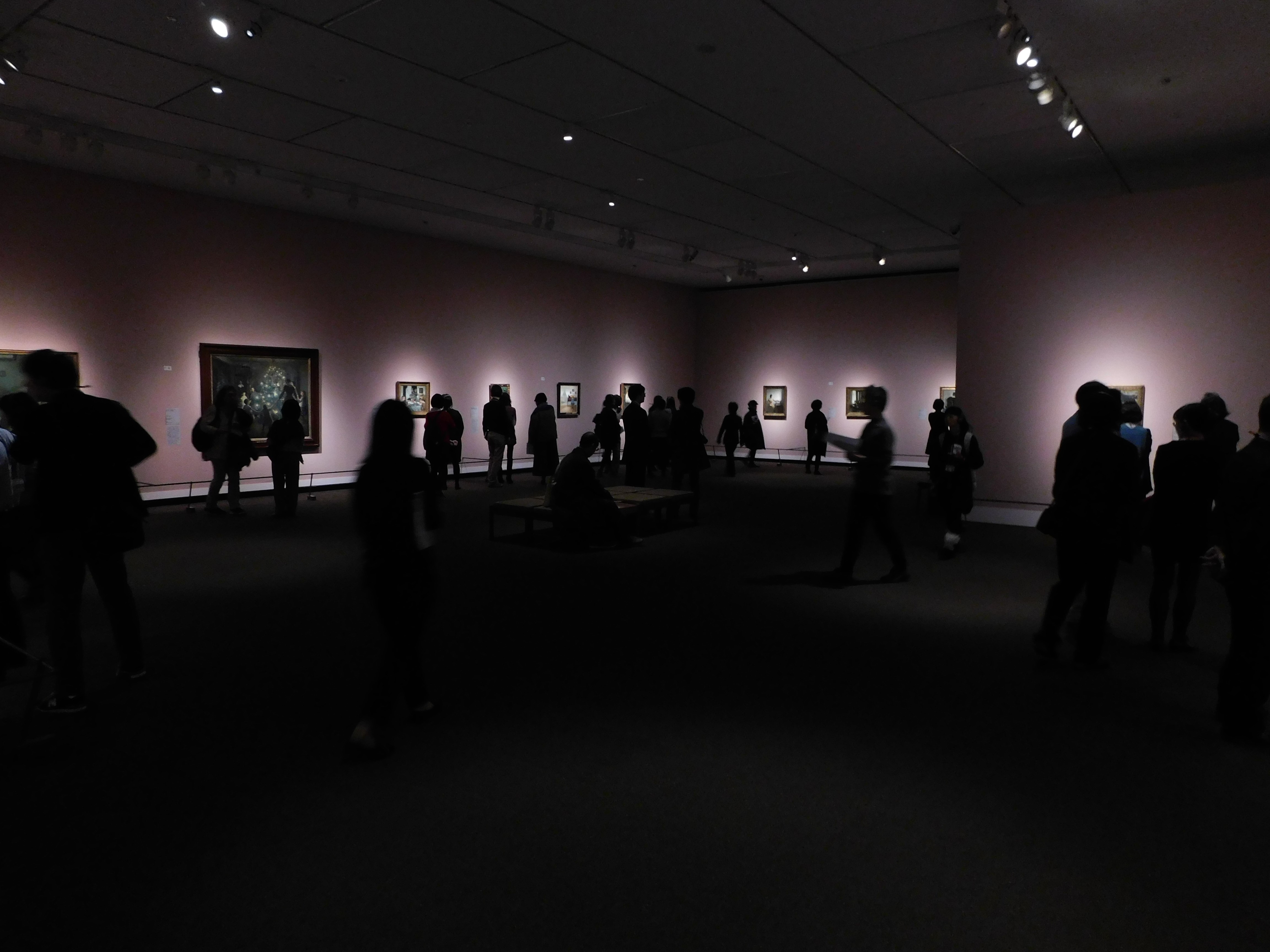
Event summary
| ■ Date: Tuesday, January 21, 2020-Thursday, March 26, 2020 |
| Venue: Tokyo Metropolitan Art Museum Exhibition Room |
| ■ Opening hours: 9: 30-17: 30 (entry until 30 minutes before closing) |
| ■ Night opening: Friday, February 19 (Wed), March 18 (Wed) 9: 30-20: 00 (entry until 30 minutes before closing) |
| ■ Closed: Monday, February 25 (Tue) * However, open on February 24 (Monday / Closed) and March 23 (Monday) |
| ■ Viewing fee: (Same-day ticket) General 1,600 yen / University / vocational school student 1,300 yen / High school student 800 yen / Age 65 and over 1,000 yen (Group ticket) General 1,400 yen / University student / vocational school student 1,100 yen / High school student 600 yen / 65 years old and over 800 yen * Group discount applies to 20 or more people * Free for junior high school students and below * Free from March 20 (Friday) to 26 (Thursday) under 18 years old (born after April 2, 2001) * Free on February 19 (Wed.) and March 18 (Wed.) due to Silver Day. Therefore congestion is expected. * Free if you have a certificate of the physically handicapped, a notebook of love, a notebook for nursing, a book of health and welfare for the mentally handicapped, a book of health for A-bomb survivors (up to 1 person) * Please bring something you can prove |
| ■ Special website: https://artexhibition.jp/denmark2020/outline-en/ |
| ■ Contact: TEL: 03-5777-8600 (Hello Dial) |
【Tokyo National Museum】Nihon Shoki 1300 Special Exhibition Izumo and Yamato Press Preview Report
Tokyo National Museum

This year of the Olympic year, Reiwa 2 (2020), is also a memorable year of 1300 since the Nippon Shoki was compiled.
To commemorate this, the Tokyo National Museum in Ueno, Heiseikan, will hold a special exhibition “Izumo and Yamato” from Wednesday, January 15 to the establishment of the Nihon Shoki 1300 .
(* First-half exhibition: January 15 (Wed)-February 9 (Sun) Second-half exhibition: February 11 (Tuesday / holiday)-March 8 (Sun))
Prior to the exhibition, there was a press preview the other day.
What is the special exhibition “Izumo and Yamato”?
Japan’s oldest Masafumi and Nihonshoki, written from Kamiyo to Emperor Joshi 11 (697),
The chief of the Tonin (Toneri Shinnou, 676-735) is the main composer,
It is a history book consisting of 30 volumes played by Emperor Gensho Tenno in Yoro 4 years (720).
In the national myth at the beginning of the Nihon Shoki, Okuninushi, enshrined at Izumo Taisha Shrine,
The existence of the world “spirit” beyond human ability, the emperor in the land of Yamato is the existence of the visible real world “ken”.
This special exhibition “Izumo and Yamato” is jointly held by Shimane and Nara prefectures, which symbolize the “Yu” and “Ken” in ancient times, and the Tokyo National Museum.
In the special exhibition, Izumo and Yamato’s masterpieces gather together to explore the formation of ancient Japan and its characteristics.
※ Enshrined (= the spirit is settled in a certain place)
Highlight
There are four highlights of the special exhibition “Izumo and Yamato”.
① Izumo Taisha Sacred treasure can be seen in Tokyo
From ancient times, you can see works telling the history of Izumo Taisha, such as the treasures such as hand boxes and armor transmitted to Izumo Taisha, giant pillars excavated from the precincts, paintings decorating the shrine.
In particular, the two pillars, the Shinto Hashida (Shino only pillar) and the Uzu Pillar (Uzuba Shira), allegedly supporting the 48-meter-long main shrine of Izumo Taisha, have been unveiled for the first time in history!
It is a valuable document that supports the existence of the main shrine of Izumo Taisha.
② Large quantity of bronze ware excavated in Tokyo for the first time in about 20 years
189 exhibits from bronze ware (copper sword, bronze dot, bronze spear) excavated from the national treasure, Kojindani archeological site, and 30 pieces from bronze spear excavated from the national treasure, Kamoi Iwakura archeological site.
This is the first time such a large amount of unearthed bronze ware has gathered in Tokyo for about 20 years.
③ Exhibition of the most excavated triangular green beast mirror
33 triangular green sacred beast mirrors that protected and calmed down the burial mounds of the Kurozuka tumulus.
As for the number excavated from one tumulus, all the points of the largest triangular green beast mirror in Japan are exhibited.
④ First public! A hidden Buddha statue
The oldest stone Buddha that has been quietly guarded in the land of Yamato for 1300 years will be unveiled outside the temple.
Pay attention to the details, such as the slight remaining coloring and the sharp digging hole.
■ Introducing the hottest exhibits!
Featured exhibits are introduced in chapters.
Chapter 1 Giant Main Hall Izumo Taisha Highlight Exhibition
“Shin-nomihashira” and “Uzu-hashira”
A pillar excavated at a depth of 1.3 meters under the grounds of Izumo Taisha Shrine in 2000.
If you look closely, there are traces of gouging on the pillars.
This is the trace of a rope and the surface of a hatchet whose surface was adjusted when logging and transporting it from the site to the exhibition room.
Even in the local area, it is not easy to display side by side,
It is a valuable opportunity.
I looked at both pillars from all angles.
I can’t actually touch my hands, but I felt that the feeling was different depending on where I touched, such as being rough or glossy.


Shimane / Izumo Taisha Shrine (stored in Shimane Prefectural Ancient Izumo History Museum)
Two pillars have been installed to reproduce the actual situation inside the premise of Izumo Taisha.
Stand between the pillars, spread your hands widely and look up to see the real feeling.

Chapter 2 Izumo
National treasure “Bronze Sword” Aragami Valley, Izumo-shi, Shimane
It is a bronze sword excavated during excavation in 1984.
All the bronze swords on display appear to be of the same size and standardized, but if you look closely, you will see a ✖ engraved on the stem.
This is considered to be a trace of the process from production to burial at once, a feature not found in other bronze swords distributed around San-in.
It makes me feel that the delicate Japanese manufacturing technology has been around since ancient times.
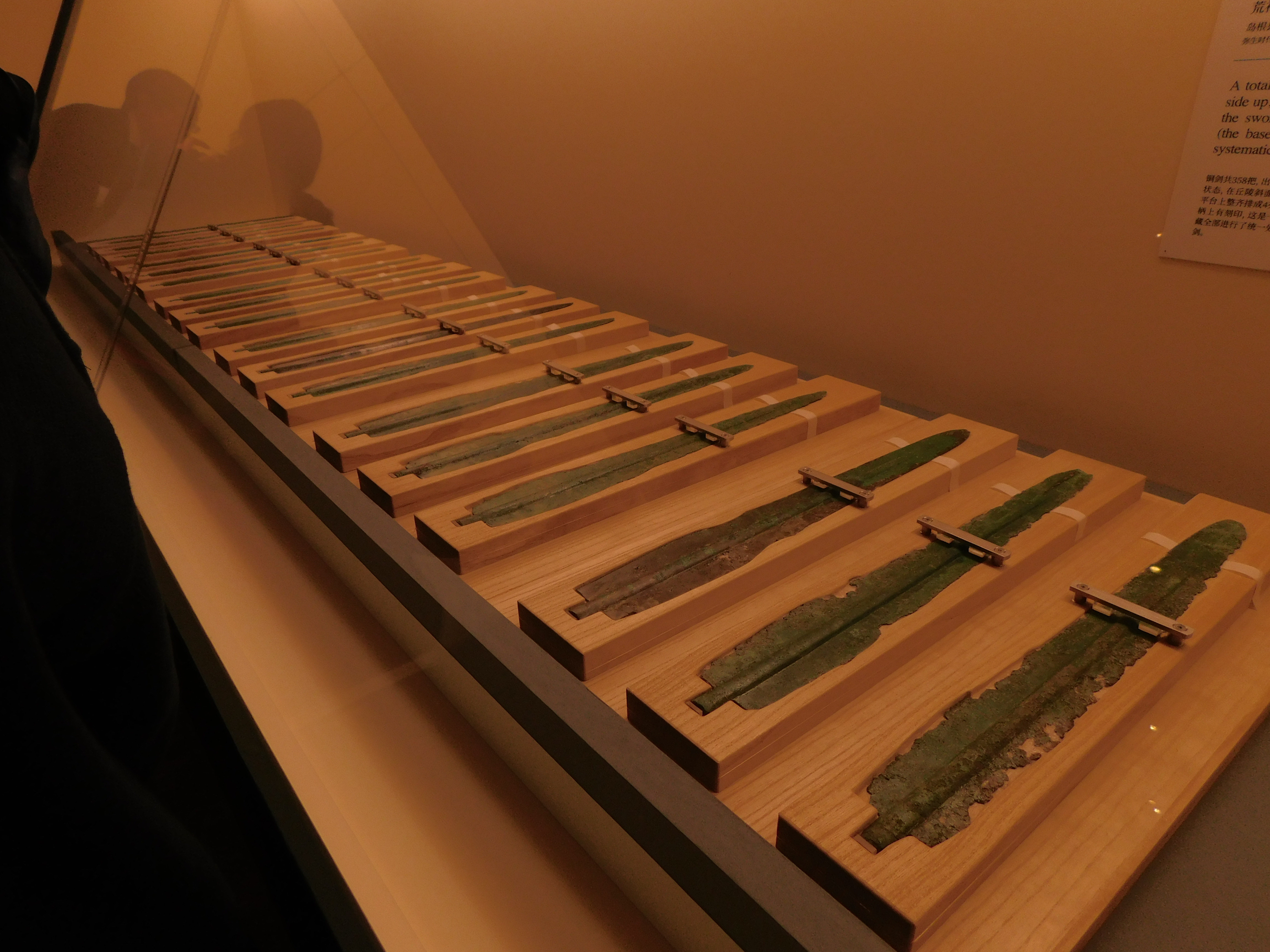
National treasure “Bronze hoko” Aragami Valley, Izumo-shi, Shimane
This is the 16 bronze hoko from the Aragami Valley, which boast the highest number of unearthed rocks in Japan.
If you compare them one by one, you will find something.
A rattled edge, a relatively clean edge,
Rusted and faded, black-brown and shiny,
And the unique bronze hoko are lined up.
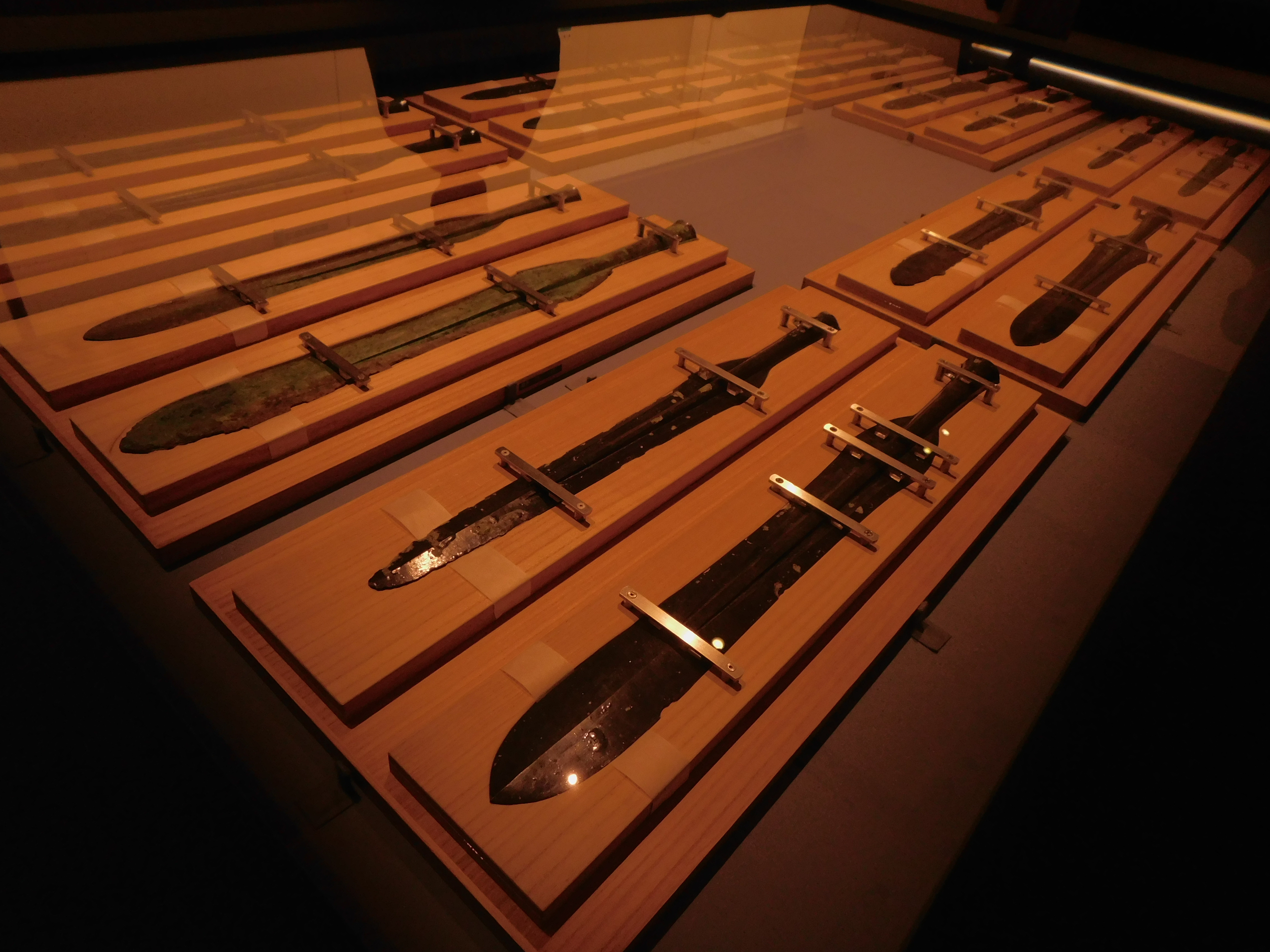
National treasure “Bontan dot” Ruins of Aragami Valley, Izumo-shi, Shimane
It is a bronze dot excavated from Aragami Valley.
There are various types, but they are almost the same size.
There are many places where the end of the bronze is scratched, and there are traces of considerable use.
What kind of thoughts did people at that time stare at at this bronze dot?
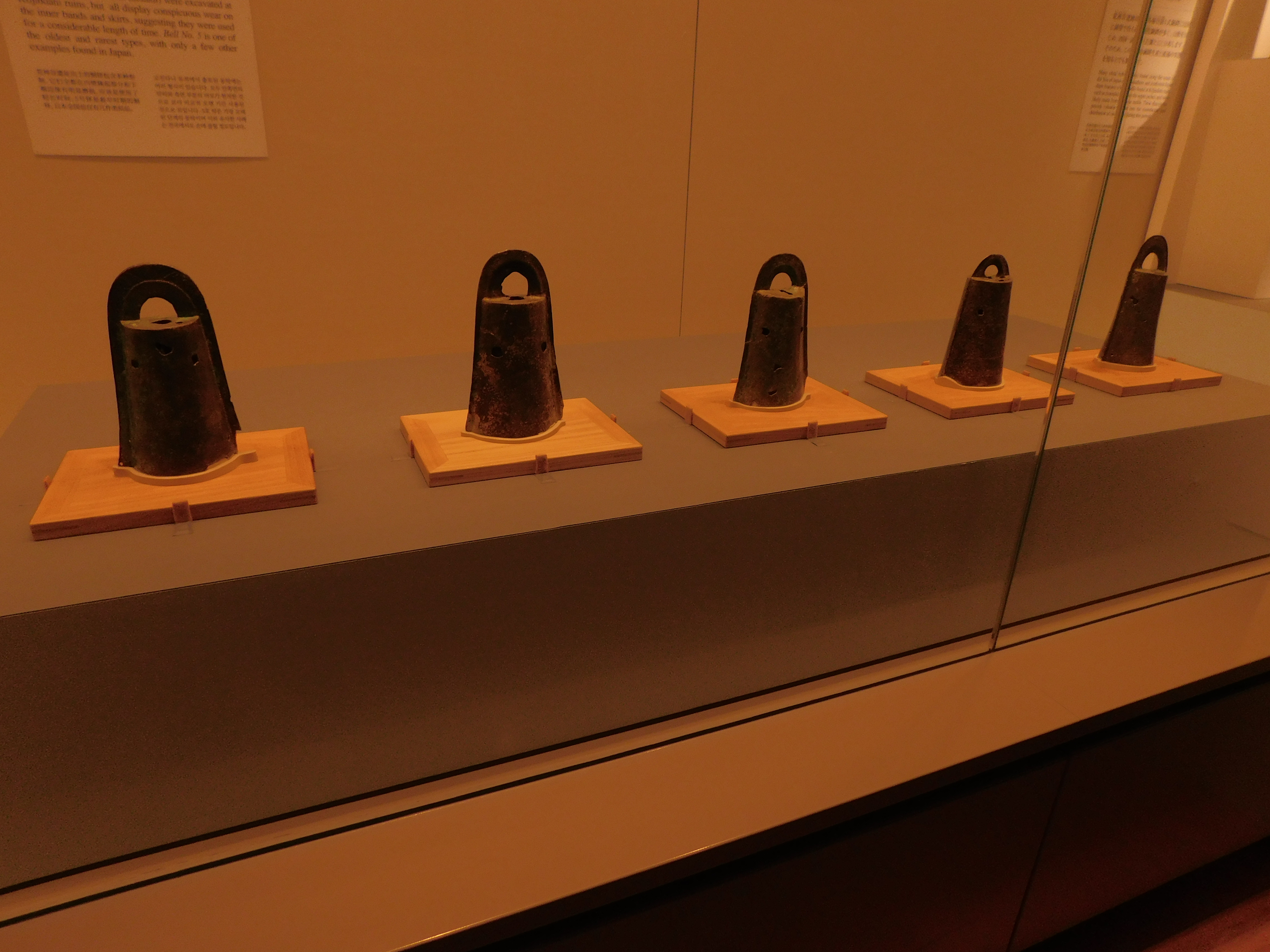
Chapter 3 Yamato
National treasure “Seven swords”
It is a treasure sword transmitted to Ishigami Jingu Shrine, and a treasure similar to the Shinto shrine.
Formerly, it was subdued in the main shrine.
A very rare type that has branches growing sideways is characteristic,
In the center is an inscription of 61 characters.
On the surface, a statement that if you have this sword, you will reject hundreds of changes,
On the reverse side, there is a statement that the royal family of Baekje on the Korean Peninsula was dedicated to the King of Wa.
It is a rare and rare opportunity to see this seven-armed sword, which is also described in the Nihon Shoki, as a seven-sheathed sword!

・ Important Cultural Property “Gamon Belt Mirror”
The “gamon Belt Mirror” displayed in the center is a copper mirror excavated from the Hokenoyama Burial Mound in Nara Prefecture.
On the outside, a car with a sun wheel, a beast pulling the car, and a sensation are shown in relief.
It is very small but has a strong presence.
・ Important Cultural Property “Triangle Beast Mirror”
The “Triangle Beast Mirror” displayed on the left and right is a copper mirror excavated from the Kamihara Shrine Tumulus in Kamo-cho, Yunnan City, Shimane Prefecture.
On the outside, patterns of Shinsen and spirit beasts are engraved.
The appearance of the 33 faces is spectacular.
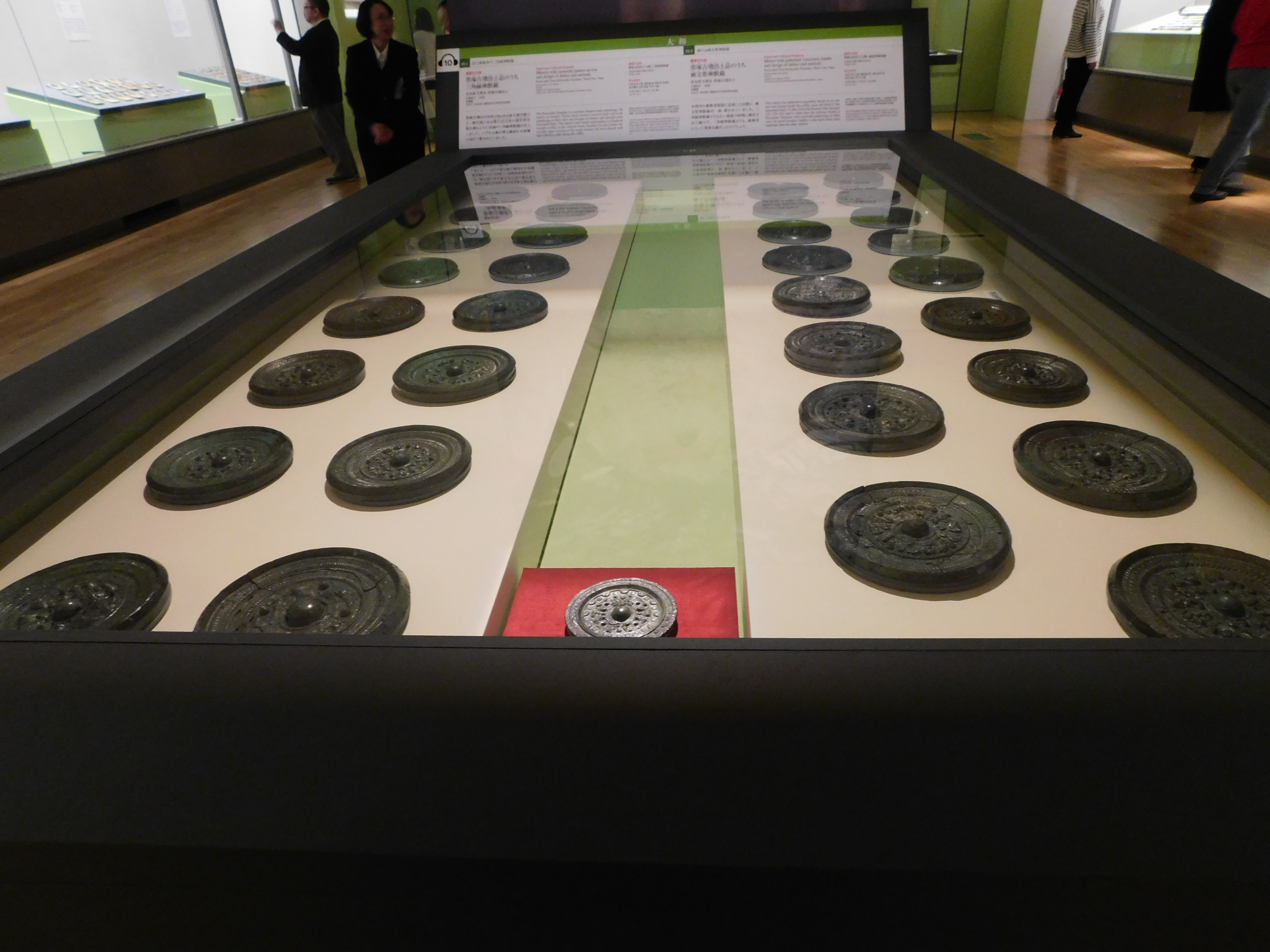
(Right and left photo) Important Cultural Property “Triangle Beast Mirror” (Tenku City, Nara Prefecture) Kuroshika Tumulus Kofun period 3rd century Bureau of Cultural Affairs (Kashihara Archaeological Research Institute, Nara Prefectural Government)
Chapter 4 Buddha and Government (the festival)
・ Two eleven-faced Kannon Bodhisattva statues
Two 11-faced Kannon Bodhisattva statues in the center of the photo.
At that time, we prayed for the great power of Kannon and wished for the prosperity of the country and the safe lives of the people.
It is strange to stand in front of the statue of the Kannon Bodhisattva, because you will feel as if you are being protected by something invisible.
・ (Of Shitenno statue) National treasure “Hirome Tendai statue” *Left
・ (Of Shitenno statue) “Tamon statue” * Right
Shitenno is a symbol of national politics.
Both the two Buddha statues are impressive with thick eyebrows and large nose.
At first, I was overwhelmed by the intimidation of the Buddha statue, but after staring at it for a while, I realized that there was a person who did not want to leave the place forever.
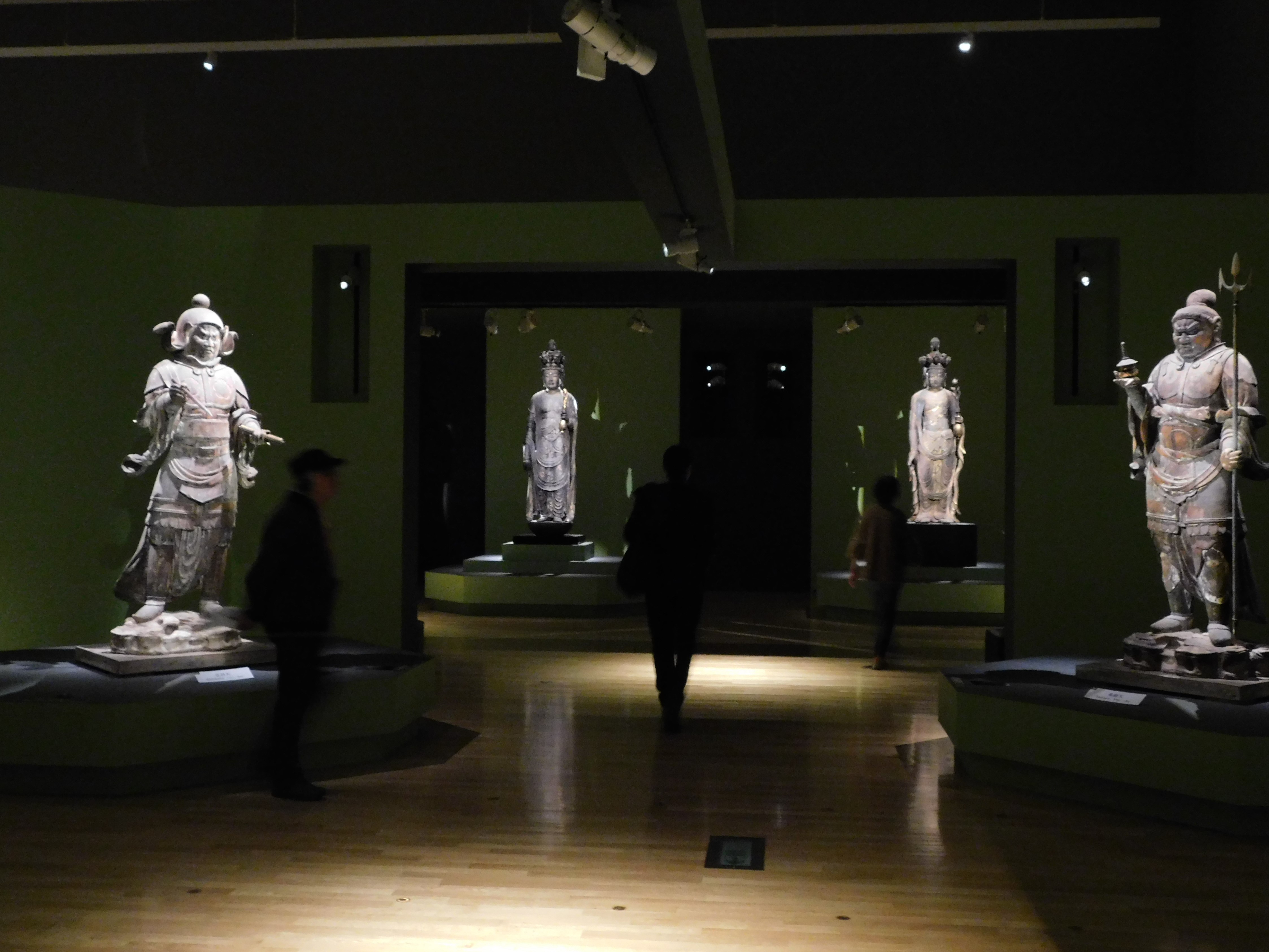
Conclusion
I have reported on the press preview of “1300 Nihonshoki Special Exhibition Izumo and Yamato”.
Works that tell the history of Izumo Taisha, a large number of excavated bronze pieces exhibited for the first time in 20 years、
33 triangular triangle Beast Mirror、Buddha statues.
All of these exhibits were full of stimulus and it was not enough just once and it was a fulfilling content that I wanted to see again and again.
The preview was really flooded with so many people that it was so hot that you had to wait to see the exhibits.
“Nihon Shoki 1300 Special Exhibition Izumo and Yamato” currently being held at the Heiseikan at the Tokyo National Museum. Why don’t you come and celebrate the 1300 year of Nihon Shoki through experiencing the process of ancient Japan? Is not it?
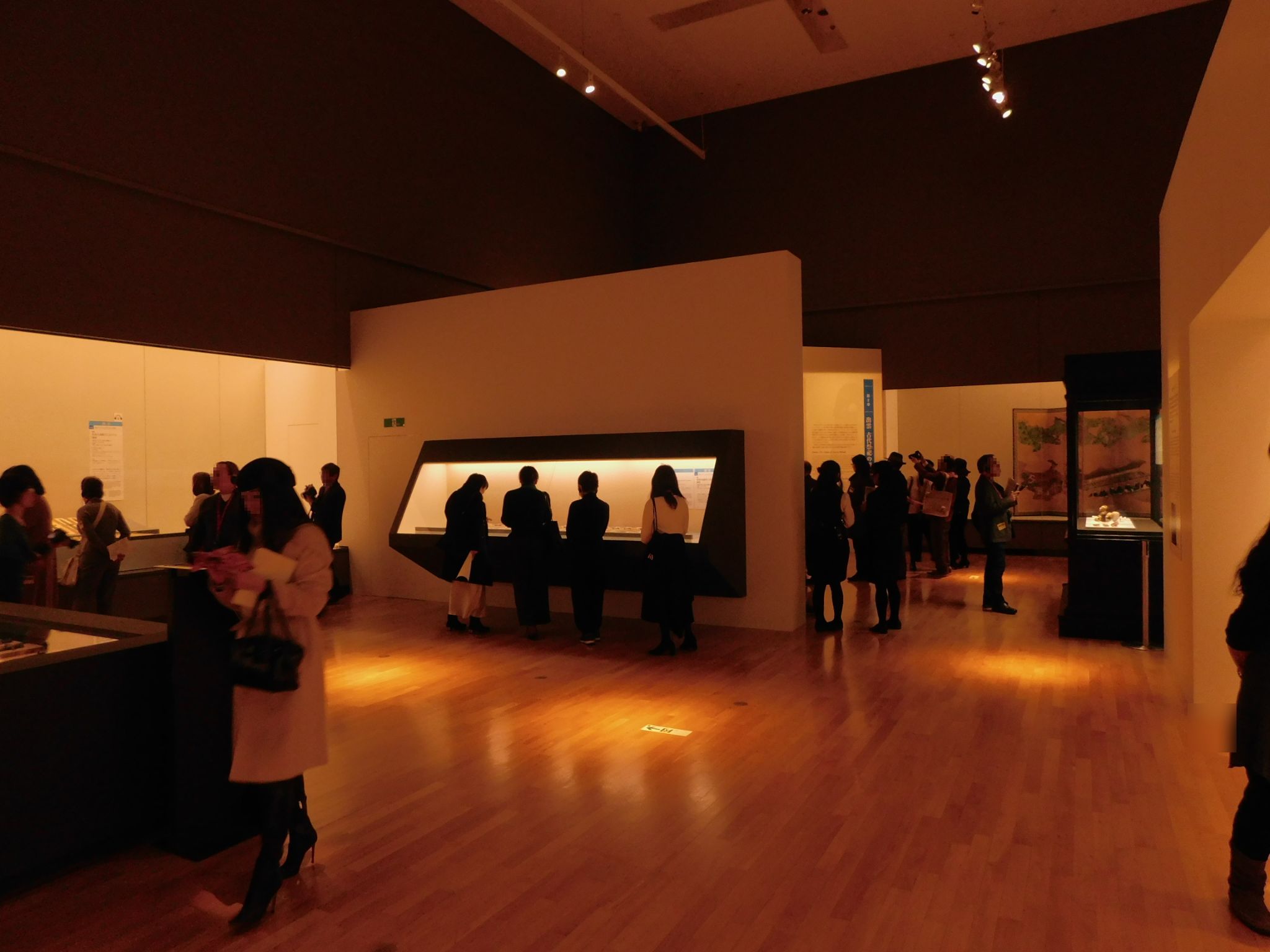
Event summary
| Exhibition name | Nihon Shoki 1300 Special Exhibition “Izumo and Yamato” |
| Session | January 15 (Wed)-March 8 (Sun) 2020 Early Exhibition January 15 (Wed)-February 9 (Sun) Late Exhibition February 11 (Tuesday / holiday)-March 8 (Sun) |
| Venue | Tokyo National Museum Heiseikan (Ueno Park) |
| Opening hours | 9: 30-17: 00 (Admission until 30 minutes before closing, open until 21:00 on Fridays and Saturdays during the exhibition) |
| closing day | Monday, February 25 (Tue) (Open on February 24 (Monday, closed)) |
| Viewing fee | General 1,600 yen (1,400 yen / 1,300 yen) University student 1,200 yen (1,000 yen / 900 yen) High school student 900 yen (700 yen / 600 yen) Free for junior high school students and below * (): Advance sale / Group rate for 20 people or more * Free for disabled people and their caregiver. Please show a handbook for people with disabilities when entering the library * Tokyo National Museum Campus Members members can purchase same-day tickets for 1,000 yen (200 yen discount). At the main ticket office, tell us that you are a Campus Members student and present your student ID card. * You can purchase a regular ticket of 1,600 yen for 1,500 yen (100 yen discount) at the “Tokyo Museum Gourtt Pass” . Please apply at the main ticket office (window). * With this exhibition admission ticket, you can also see the general culture exhibition (normal exhibition) only once on the day of the exhibition day during the exhibition. |
| Contact us | Hello dial 03-5777-8600
Reception hours: All day from 8 am to 10 pm |
| Official HP | https://izumo-yamato2020.jp/ |
【National Museum of Nature and Science】 Report on the Press Release of “The Journey of Life through Picture Books”
National Museum of Nature and Science

From December 17, 2019 (Tuesday) to March 1, 2020 (Sunday), the “Journey through Life with Picture Books” is being held at National Museum of Nature and Science in Ueno, Tokyo.
The press briefing was held the other day, so I will report on the situation.
We will introduce the highlights of the exhibition and the hottest exhibits.
What is the special exhibition “Journey through life through picture books”?
An evolutionary process that began on the earth and emerged on Earth about 3.8 billion years ago.
It is no exaggeration to say that people and various creatures continue to exist because their evolution has continued without interruption.
There are many picture books on science and nature that focus on the evolutionary process of such creatures.
“By combining science and nature-based picture books with museum exhibits, we hope to stimulate interest in natural science and provide a different way of enjoying the National Science Museum.” This exhibition.
In a picture-story show format, the origin of life will be displayed in an easy-to-understand manner.
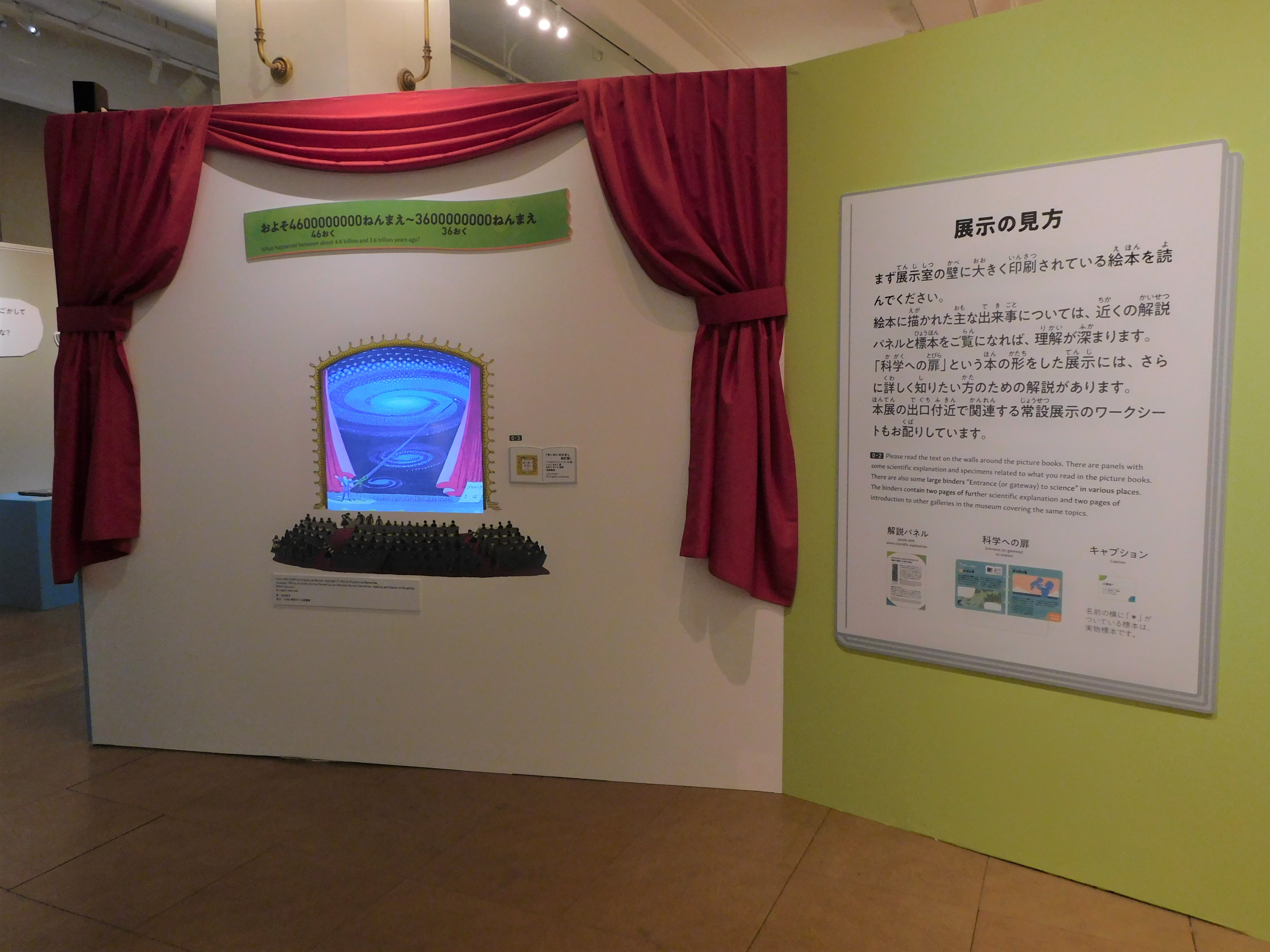
Highlight
We will introduce the highlights of the special exhibition.
① You can experience a new picture book at the National Science Museum !?
At the special exhibition, scenes selected from seven picture books are displayed together with specimens such as fossils and foil.
You can trace the history of life evolution with specimens while enjoying the world of picture books.
② You can feel the evolution from fish to human!
In the exhibition, the main events of life evolution for about 500 million years, from fish to humans, are explained in a particularly easy-to-understand manner.
Feel the connection of life that continues from our distant ancestors to the present, the evolution that remains in our bodies.
③ If you want to know more …
If you want to know more about this exhibition and want to know more widely, please visit the permanent exhibition.
There is a corner that introduces research and research conducted at the National Science Museum and related permanent exhibits.
You may encounter a new picture book!
Near the entrance of the exhibition, there is a reading corner with over 100 picture books related to natural science and the evolution of life.
Reunite with nostalgic picture books, you may be able to meet your favorite new picture books.
Picture books in languages other than Japanese are also available.
Main picture books used in the exhibition
The following seven works are used in the exhibition.
| (1) “Some no Kiyoshi” | Virginia Lee Burton Sentence / picture, Iwanami Shoten |
| ② “Long journey” | Motofumi Matsuda, Kazuo Kawakami Picture, Kodansha |
| ③ “I’m the grandmother of everyone’s first evolution” | Jonathan Tweet text, Karen Lewis picture, Iwanami Shoten |
| ④ “Totori became a story” revised edition | Eitaro Oshima, Gospel Museum Bookstore |
| ⑤ “The Origin of Species” Darwin’s First Evolution Theory | Sabina Ladeva, painting and painting, Iwanami Shoten |
| ⑥ “Expanding Life” | Keiko Nakamura, Tatsuhide Matsuoka Picture, Gospel Museum Bookstore |
| ⑦ “13.800 billion times” | Osamu Sakai product, picture, Kobunsha |
Introducing main exhibits
Anomalocaris, a predatory animal that inhabited about 508 million years ago (mid-Cambrian)
It is said that he was given a scientific name in the sense of a strange shrimp.

A head fossil that inhabited about 360 million years ago and is presumed to be an ancient fish eustenopterone. , Donated to the National Museum of Nature and Science.
You can actually touch it.
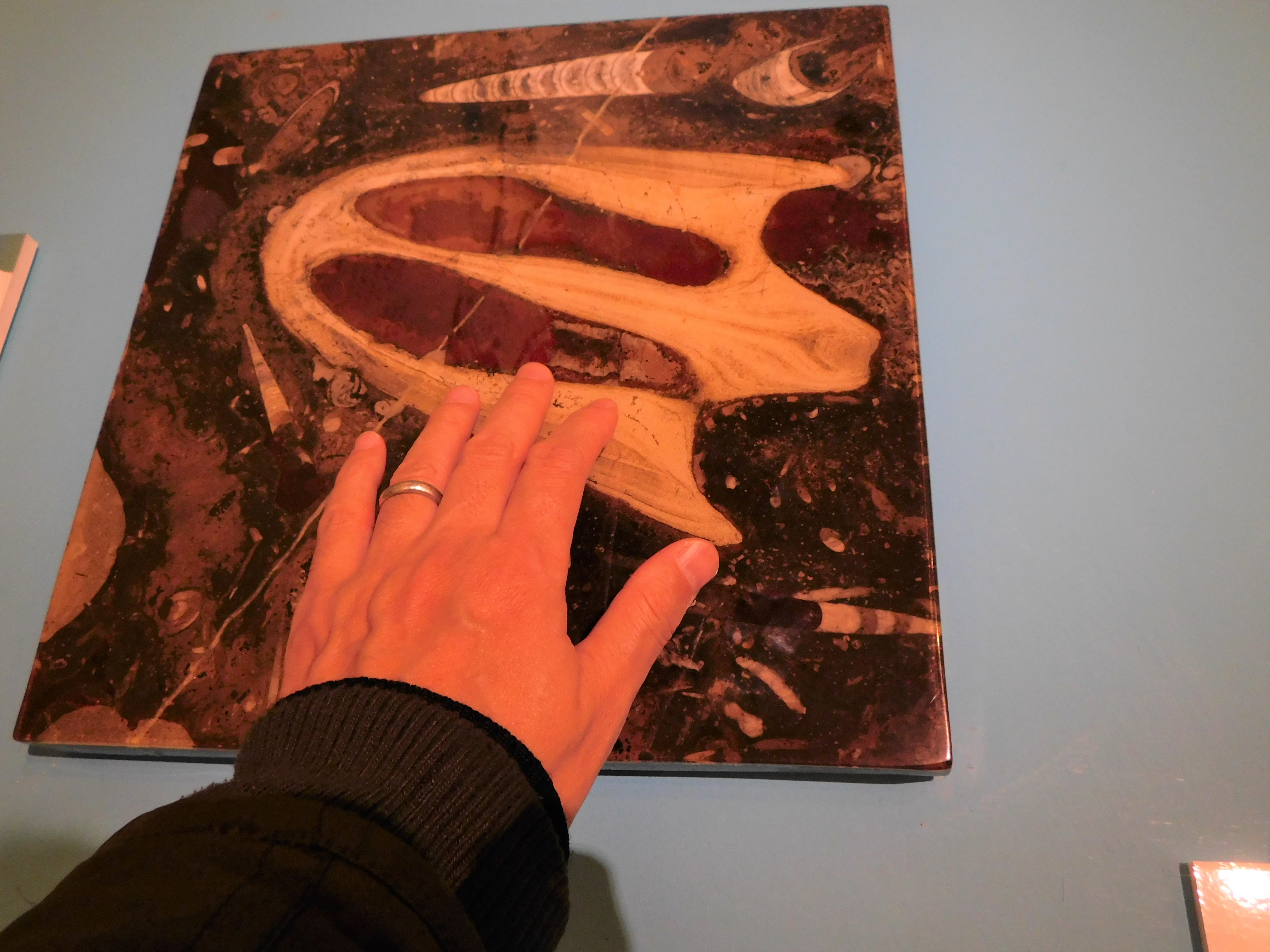
Here is the whole body of Eustenopterone.

Deinonyx, which inhabited about 115-118 million years ago.
It often appears in movies and animations.
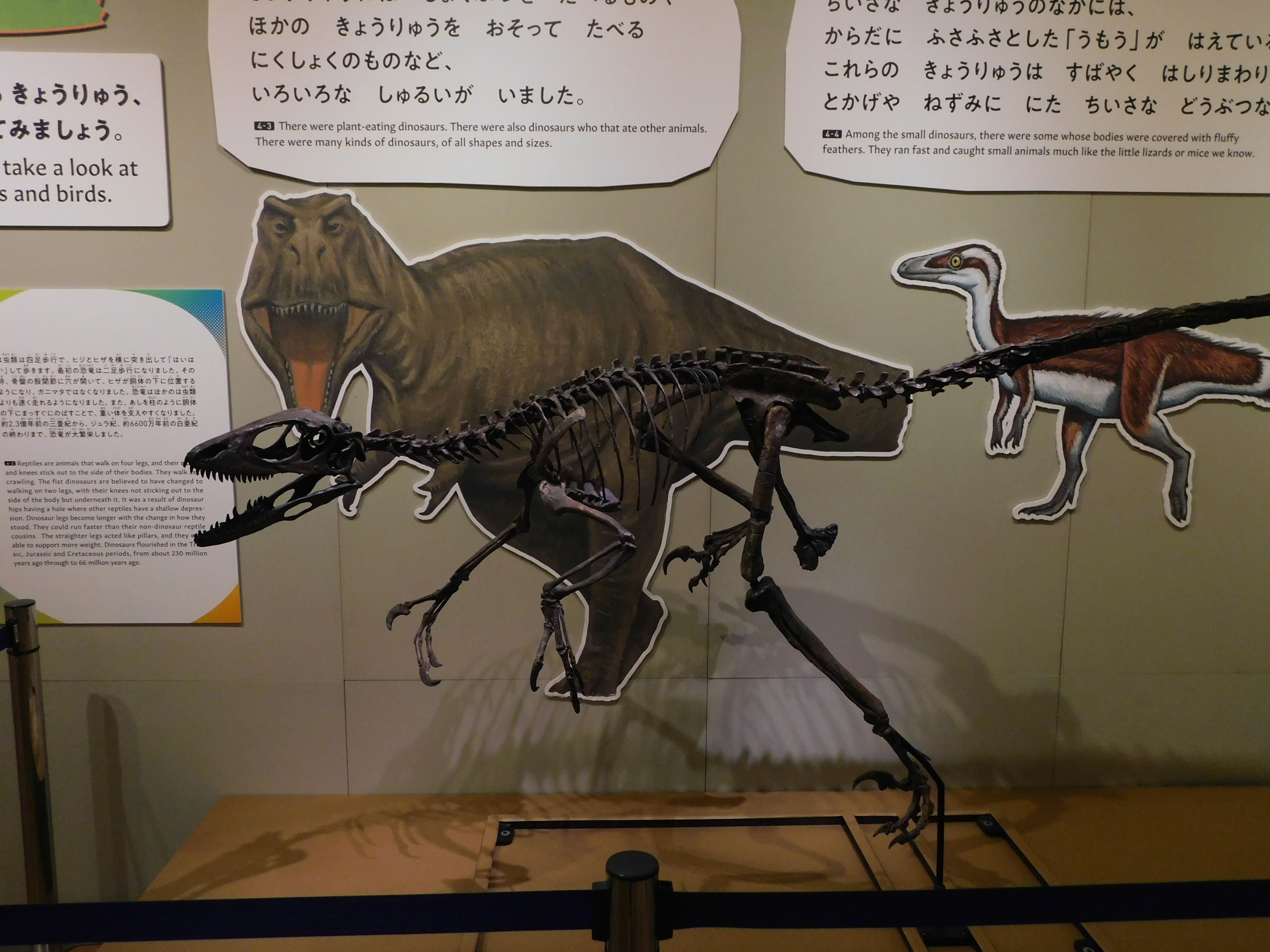
A fossil of the carnivorous mammal hyenodon that inhabited about 30 million years ago.
Mammals up to the dinosaur had ribs on their stomachs and could not hug them even if they wanted to hug a child.
Later, when the diaphragm was formed and the way of breathing changed, mammals could now hug and feed their baby.

In life from 7 million years ago to 200,000 years ago, fingers and toes become longer, and some things move differently from other creatures.
You will be able to grab the branches with your limbs, live on the tree, and communicate with each other by singing.
That is the present human ancestor of human beings.
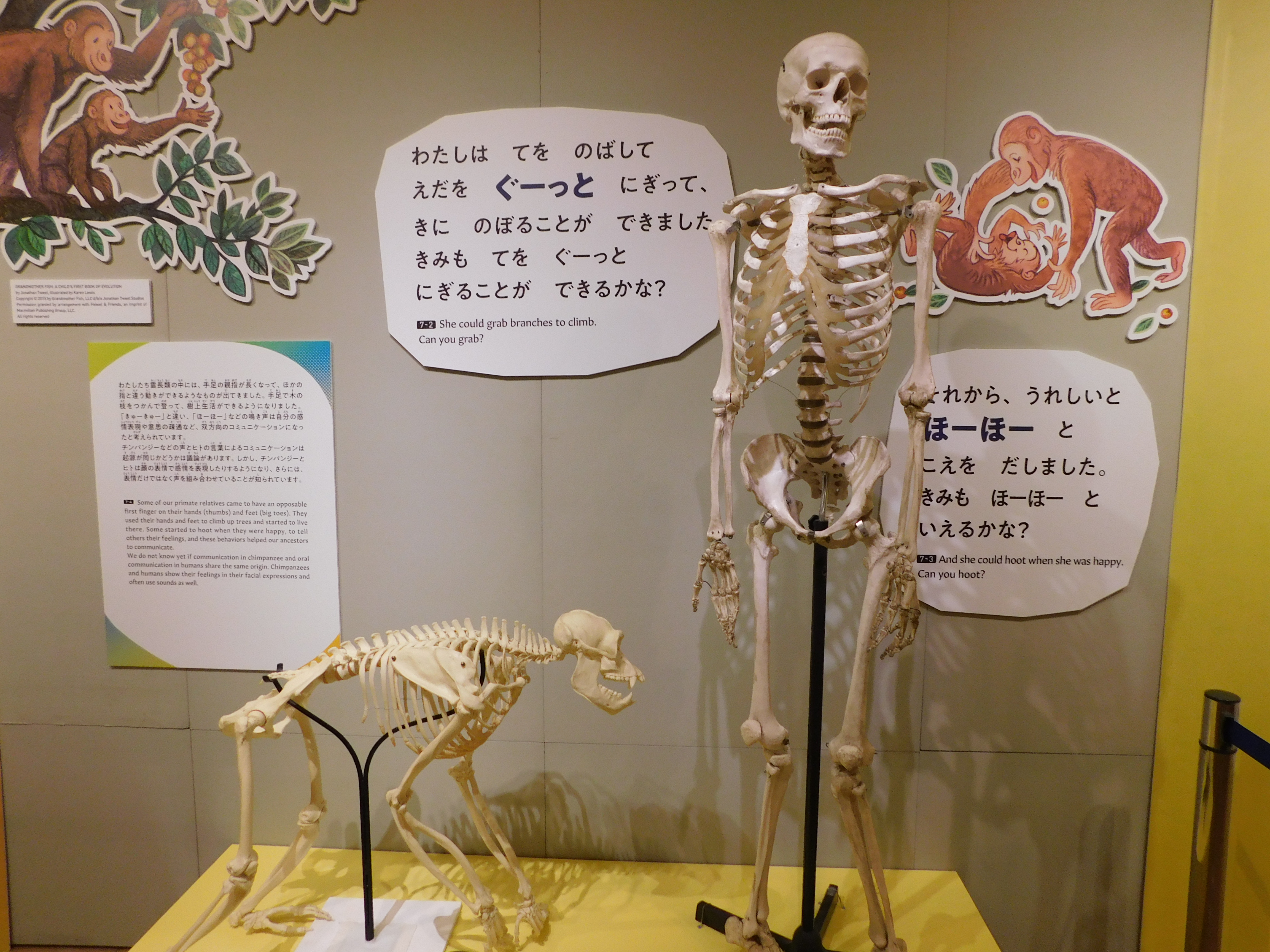
Picture book corner inspired by Darwin’s Beagle
After watching the exhibition, look for your favorite picture books related to natural science and the evolution of life at this reading corner.
You can also see the seven picture books featured in the exhibition.
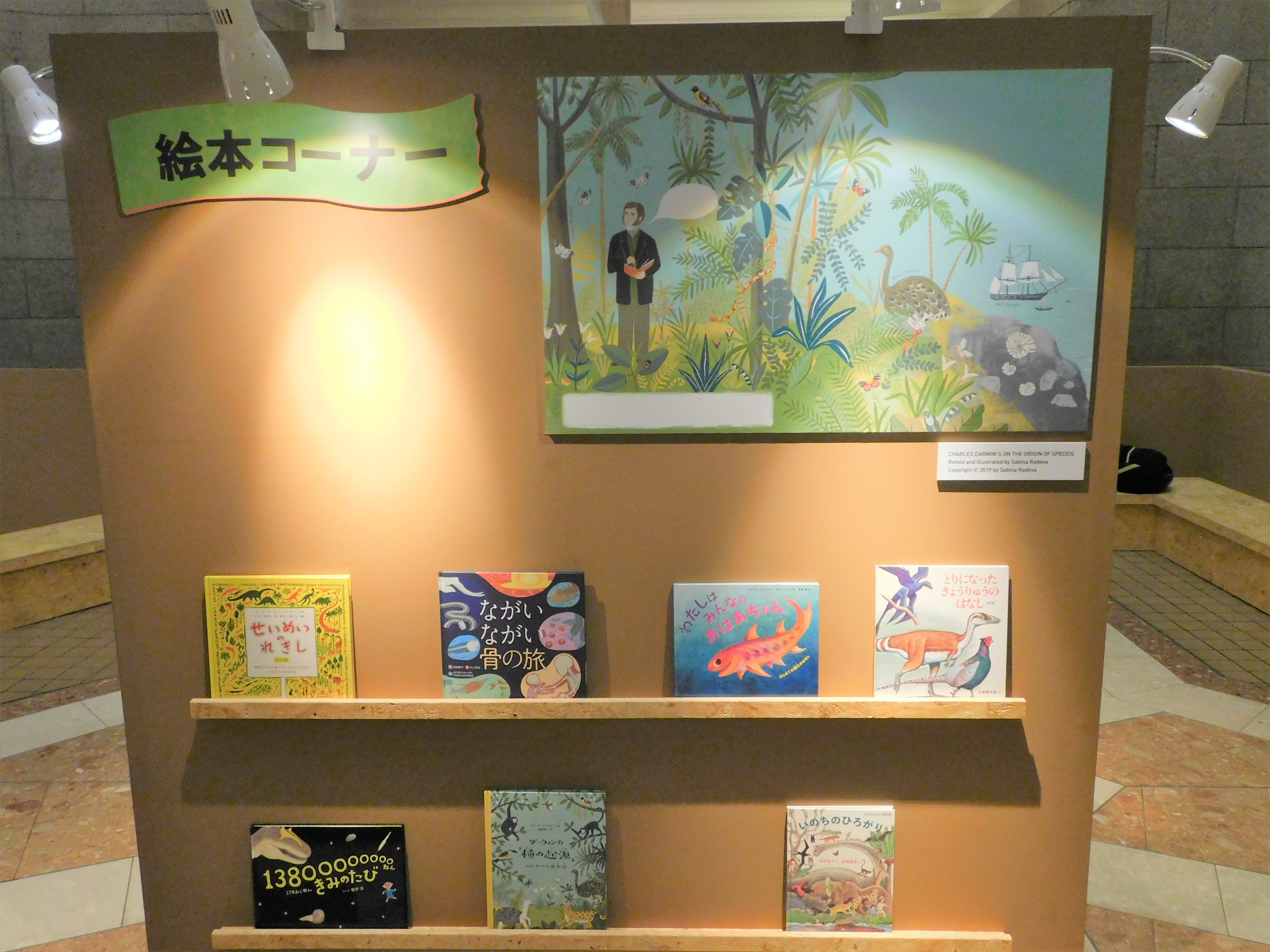
Conclusion
I’ve told you about a press preview of the exhibition “Journey through Life with Picture Books” currently being held at the National Science Museum.
The history of creatures that has continued from about 3.8 billion years ago to the present.
We humans seem to be living a matter of course, but in fact, we realize again that this is the life of billions of years of history.
Why do not you go to the National Science Museum on a journey of life with family and friends with picture books?
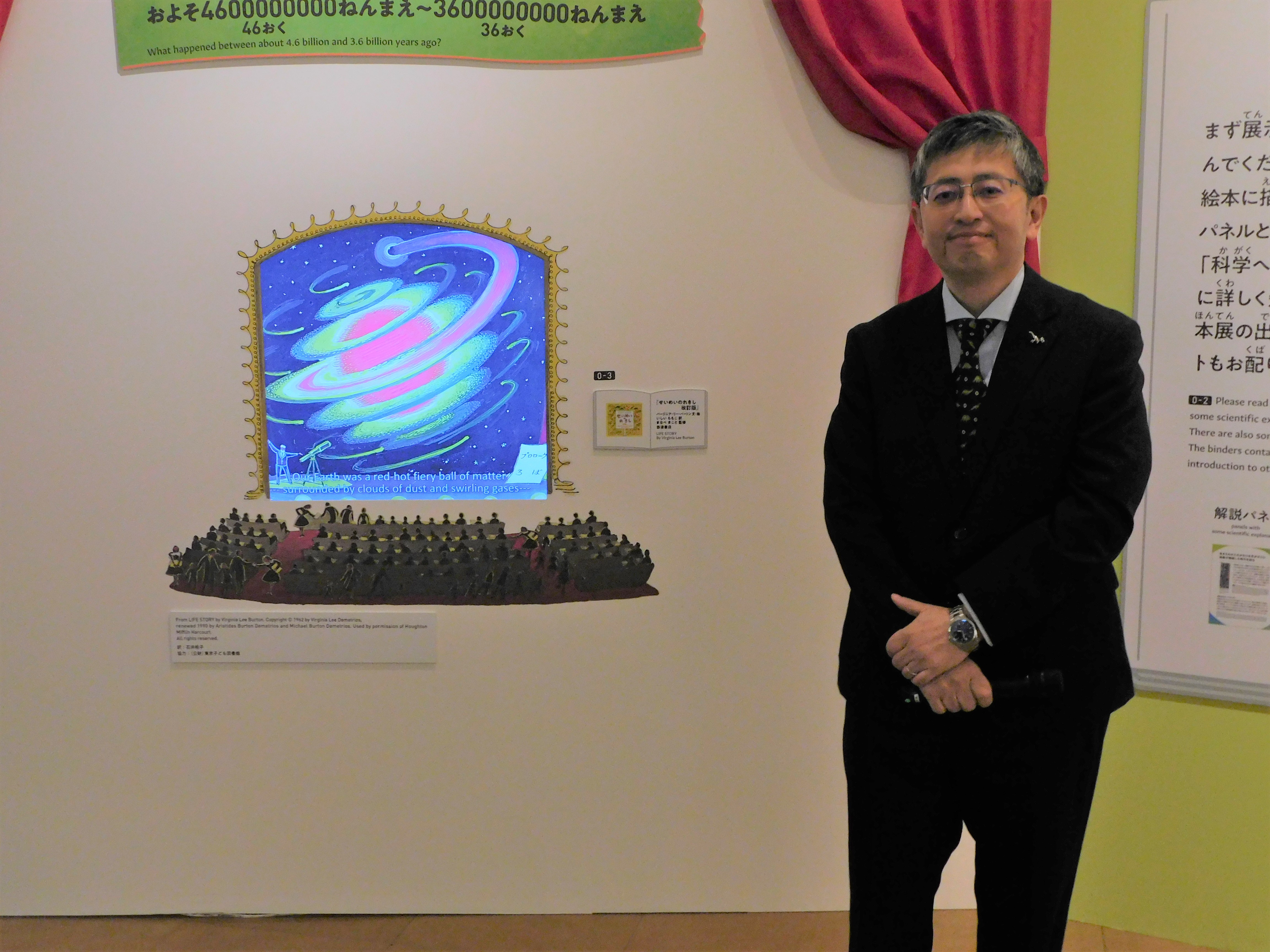
Mr. Makoto Manabe, Director of the Collection at National Museum of Nature and Science、 who supervised this exhibition、had a fun explanation about the history of life.
Event summary
| Exhibition “Journey of life through picture books” |
| Period: December 17, 2019 (Tuesday)-March 1, 2020 (Sunday) |
| Venue: Japan Pavilion 1F, Special Exhibition Room, Central Hall |
| Opening hours: 9 am to 5 pm * Friday and Saturday until 8pm. * Admission until 30 minutes before closing time |
| Closed: Every Monday (Tuesday if Monday is a national holiday) and from December 28 (Sat) to January 1 (Wed / Holiday), except on February 17 (Mon) |
| Admission: General and university students: 630 yen (510 yen for groups) High school students and under, 65 years and over: free * You can see only the permanent exhibition admission fee. |
| Organizer: National Science Museum Official HP: https://www.kahaku.go.jp/english/ |
Tokyo National Museum、the annual New Year’s event “First in the Museum” will be held from January 2 (Thu) to 26 (Sun), 2020!
Tokyo National Museum
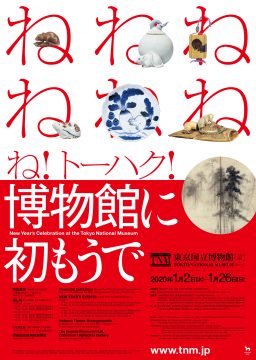
The Tokyo National Museum will open from January 2nd in 2020, and will hold the annual New Year’s event “First time at the museum”.
This year’s zodiac is “the mouse”.
You can see many special items such as the special feature of the zodiac theme that has become an annual event, and the national treasure “Matsubayashi Utsukaze” (written by Hasegawa etc.).
In addition, traditional Ikebana, Japanese drums, lion dances, and other events that color the New Year will be held at once, so you can enjoy the New Year in Japan.
It can be enjoyed as an opportunity to experience Japanese traditional culture, or as a family or couple.
<Special feature: “First in a museum, child, nephew, mouse”>
January 2 (Thu)-26 (Sun) Main building special 1 room, special 2 rooms
The beginning of the zodiac is ancient China.
Originally, it is a concept that refers to the calendar and direction, and is still closely related to our lives.
By the way, in 2020, the childhood year, we will select and display works that are named after Tohaku’s collection.
Introducing the various faces of the samurai, such as the twelve children, the samurai as the angel of Daikokuten, and the samurai, the symbol of progeny.
Please enjoy the stylish scarlet kimono that was popular in the Edo period and the performance with the eternal rival cat.
・ Gallery Talk “Daikokuten and Aoi”
January 21 (Tue) 14: 00-14: 30 Special 1 room in the main building
Lecturer: Masanori Kono (Researcher of Archaeology)
I will explain the coral that has been loved by people as a symbol of child treasure, prosperity, and happiness, in association with the gods.
・ Main exhibition works * All are from the National Museum of Tokyo
袱 紗 Indigo radish rice radish pattern / Edo period, 18th to 19th century / Donation of Mrs. Henry
https://www.atpress.ne.jp/releases/199959/img_199959_3.jpg
鼠 蒔 絵 印 籠 String lacquered red lacquer “Masami Shiomi” / Meiji period, 19th century / Quincy A. Donated by Mr. Shaw
https://www.atpress.ne.jp/releases/199959/img_199959_4.jpg
Dyed radish platter Imari / Edo period, 19th century / Donated by Kosuke Hirano
https://www.atpress.ne.jp/releases/199959/img_199959_5.jpg
<Introducing New Year’s Specialty Products This year, we will display the national treasure “Matsubayashi Zukan” and various special items that will end the beginning of the year. >
National treasure “Matsubayashi picture folding screen” by Hasegawa, etc. Azuchi Momoyama period, 16th century
https://www.atpress.ne.jp/releases/199959/img_199959_6.jpg
January 2 (Thu)-January 13 (Mon / holiday) Main building 2 rooms (national treasure room)
This is a destination where Japanese ink paintings have arrived.
National treasure “Komaima Wakashu (Motonagamoto Shimojo)” Heian period, 12th century / Donated by Mitsui Takadai
https://www.atpress.ne.jp/releases/199959/img_199959_7.jpg
January 2 (Thu)-January 19 (Sun) 3 rooms in the main building
Please pay attention to the continuous cotton and the beauty of the margins unique to Japanese books.
Important cultural property “ Gose-jo carp picture box ” Edo period, 17th century
https://www.atpress.ne.jp/releases/199959/img_199959_8.jpg
January 2 (Thu)-March 22 (Sun) Main building, 12 rooms
Chrysanthemum blooms on the shore in flowing water overlooking the state beach.
<Events On the 2nd and 3rd of the New Year, traditional Japanese performing arts such as Japanese drums and lion dances are also held. >
January 2 (Thursday) 11: 00/13: 15 Japanese drum Yushima Tenjin Shiraume Taiko Toyokan
11: 45/14: 00 Lion Dance Kasai Rin Nakamura Shachu Toyokan-mae
Friday, January 3 11: 00/13: 15 Japanese drum Yushima Tenjin Shiraume Taiko Toyokan
11: 45/14: 00 Lion Dance Kasai Rin Nakamura Shachu Toyokan-mae
12: 30/14: 45 Clarinet Concert (Julian’s) Heiseikan Lounge
* Location may change or be canceled in case of rain.
■ Ikebana January 2 (Thu)-January 13 (Mon / Holiday)
Main gate, main building entrance, main building large staircase
■ New Year only! We distribute worksheet with calendar
The worksheet will be distributed to the first 3,000 visitors (each day) on the 2nd and 3rd of January. The back of the worksheet for enjoying the special feature “First time at a museum, baby, mouse and mouse” is the 2020 calendar. Worksheets will be distributed from 11:00 to 16:00 in front of the 2nd floor of the main building.
※ It will end as soon as it runs out of time.
■ Present from TNM & TOPPAN Museum Theater January 2 (Thursday) and 3 (Friday) 2020
A free theater ticket and original goods will be given to those who enjoyed VR work.
* A separate fee and reservation on the day are required for viewing.
* Please refer to the website ( http://www.toppan-vr.jp/mt/) for details.
■ Present from Hotel Okura Restaurant Lily Tree January 2 (Thu) and 3 (Fri) 2020
The first 200 customers who use lily trees will receive a chopstick rest from Iyo’s Mizuhiki.
■ New Years from the Museum Shop January 2 (Thursday) and 3 (Friday) 2020
Customers who purchase more than 3,000 yen at all museum shops in Tokyo National Museum will receive a gift of museum goods for the first 300 guests on both days.
Art book bargain sale (only for main building museum shop)
■ Kaneiji Nemoto Chudo Special Worship January 2 (Thursday) and 3rd (Friday) 2020 10: 00-15: 00
Nemoto Chudo, portraits of Tokugawa successive shoguns, statues of the four celestial kings, etc. will be released. Please present the stub for the hotel admission ticket (for the day). I will give you a scatter.
[Visitor Information]
| ■ Opening hours: 9: 30-17: 00
* Opens until 21:00 on Fridays and Saturdays ■ Closed: Monday, December 26 (Thursday) to January 1, 2020 (Wednesday / Holiday) ■ Admission fee: General 620 yen (520 yen), University student 410 yen (310 yen) ■ Transportation: A 10-minute walk from JR Ueno Station Park Exit and Kabuya Station South Exit A 15-minute walk from Tokyo Metro Ueno / Nezu Station and Keisei Electric Keisei Ueno Station |
Article Provided by:Kokosil Ueno
See other exhibition information
【National Museum of Nature and Science】 Special Exhibition Electronic Instrument 100 Years Exhibition-I can hear the exciting future-
National Museum of Nature and Science

“Thermin” was invented in 1920 by Dr. Lef Theremin of Russia.
Theremin, which appeared as the world’s first electronic musical instrument, was born and will celebrate 100 years next year in 2020.
Prior to this, a special exhibition “100 Years of Electronic Musical Instruments” was held at the National Science Museum from 12/3 (Tue).
The other day, there was a press conference for this exhibition.
Please see the editorial department’s notable plans for the 100th electronic musical instrument exhibition with photos.
What is an electronic musical instrument 100-year exhibition?
As mentioned earlier, the electronic instrument 100-year exhibition is a special exhibition that commemorates 100 years since the invention of the world’s first electronic instrument theremin.
By experiencing the history of the development of electronic musical instruments through precious exhibits, concerts, the latest sounds, video, and talk shows, you can enjoy electronic music from various perspectives from a scientific and artistic perspective.
Electronic instrument 100 years exhibition
Introducing the notable plans of the 100th year electronic musical instrument exhibition.
① Electronic musical instrument theme exhibition “Senestecia” (National Museum of Science, Japan Hall, 1st floor, Central Hall)
* December 3 (Tue) -December 8 (Sun)
Central hall to be themed exhibition.
In the atrium space surrounded by marble, you can experience the creativity of electronic musical instruments using sound, video and light (= Senestecia).
Experience the masterpieces of Isao Hamada’s numerous synthesizers in three dimensions with sound and video.
Successively, you can enjoy vocaloids and the latest unique electronic musical instruments in a special demonstration space.
You can enjoy masterpieces of Isao Hamada’s synthesizer in a colonnade surrounded by marble.
Along with the music, the image and fluorescent panel will change.If you stand in the center, you can experience the power of sound from all sides.

Vocaloid, an electronic musical instrument that utilizes speech synthesis technology.
When you play the keyboard, the singing voice comes out.
Converts sounds made by speech synthesis as if humans were singing.
With this technology, Crimpton Future Media’s Hatsune Miku was a big hit and became a hot topic.

At the venue, the vocaloid was actually played.
If you make a mistake in the place where you play it, you will end up with a sloppy song.
Children can also play, so please enjoy the live feeling of electronic musical instruments.
In the central hall, you can enjoy many other unique electronic musical instruments.

In the central hall, you can enjoy many other new and unique electronic musical instruments.
Electronic percussion aFrame (Electro Organic Percussion)
This is an electronic musical instrument that Mr. Taro Kakehashi has been focusing on at the end of his life.
Hit or scratch.
Although it is digital, it can be struck in an analog sense.
Since the sound changes depending on where you strike, please enjoy the change in sound.
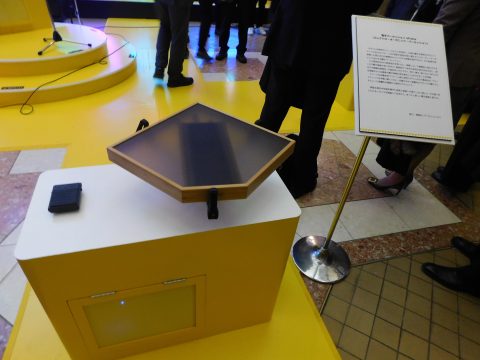
Voice Transformer VT-4
A sound processing device that adds various changes to your voice.
By turning the knob, you can enjoy the voice of a different character, such as a female voice changing to a thick male voice.
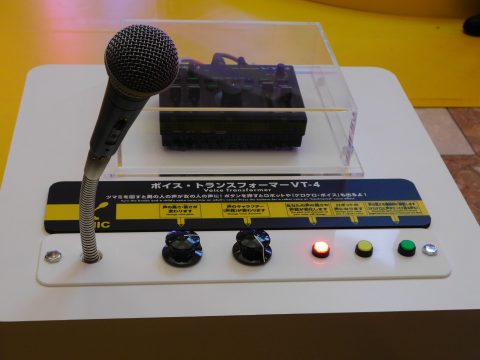
MIDI music box (Primotone crystal model)
This is an electronic music box that plays live performances by playing comb teeth using technology that converts electronic musical instrument MIDI data into motion.
It is possible to play up to 1000 songs.
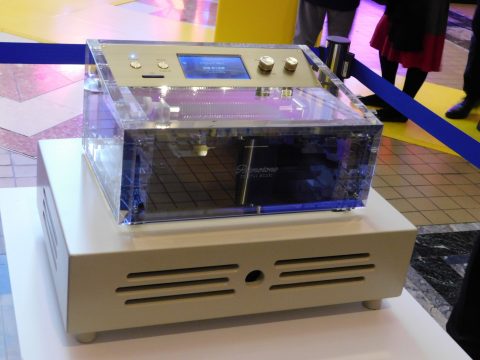
②Special exhibition “Greats of Electronic Musical Instruments” (National Museum of Science, Japan Building B1F Multipurpose Room)
* December 3 (Tue) -December 15 (Sun)
Dr. Lef Theremin is said to have invented the world’s first electronic musical instrument.
Isao Isoda who actively incorporated electronic musical instruments into his work and opened up new grounds in music.
Ryotaro Bandai, who is called “INNOVATOR” overseas and devoted his life to the development of electronic musical instruments.
You can check the history and achievements of the three great electronic musical instruments in many exhibits.
Exhibits by Mr. Ikutaro Kakehashi
Canary Model S-3 (ACE Electronics) 1962
Electronic keyboard with 6 octave range of 5 octaves + 1 octave.
Product introduced overseas prior to domestic.
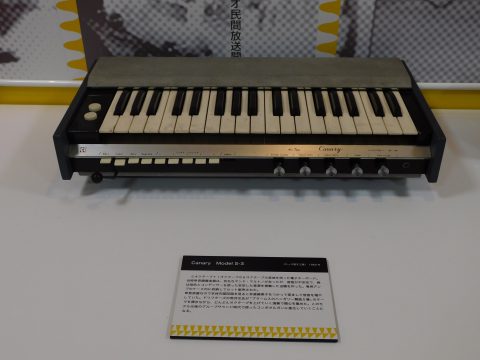
(Front) Tuner Gun Ace Electronic Industry Mid 1960s
Tuner type pistol tuning fork.
(The back of the photo) DATARAME38 Privately made by Taro Kakehashi Near 1974
When Ladder went to Scandinavia on a business trip abroad, he bought a computer system part for the S-100 bus and combined it with handmade junk parts from a Japanese office computer to complete it by hand.

MC-8 (Roland) 1977
5, 400 sounds, at that time, large storage capacity, 8 CV / GATE outputs, performance of up to 8 independent parts, backup with data recorder, and groundbreaking spec product.In Japan, Isao Tomita and YMO Associate member of (Yellow Magic Orchestra) -used by artists such as Hideki Matsutake.

TR-808 (Roland) 1980
32 types of rhythm creation and editing are possible.
It is a revolutionary rhythm machine that can create a rhythm pattern for one song by freely combining the created patterns.
In September 2019, it was registered as a future technology heritage.
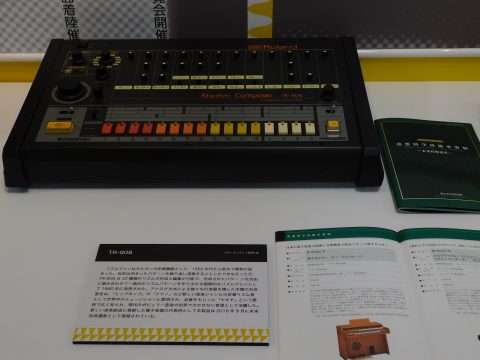
Exhibition of Isao Tomita
Numerous trophies won by Isao Tomita are on display.
Trophy selected as the best classical record album for the second consecutive year by the NARM National Record Seller Association album.
(Left) 1974 album “Snowflakes Are Dancing” (Japanese title: Tsuki no Hikari)
(Right) Awarded for the 1975 album “Picture of the Exhibition”.
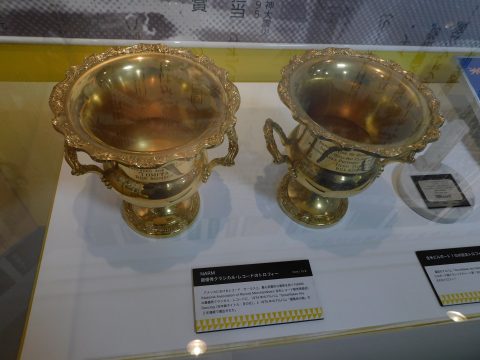
A handwritten score by Isao Tomita is also on display.

Lef Theremin exhibits
In front of the photo of Leftermin is a theremin box invented in 1920.
It is the first model of Theremin.
The theremin box means “the voice of theremin” in Russian.

Later, the improved model became a box-type theremin box.
The inside of the box is a vacuum tube.

It is a modern theremin.
(Left) Matryomin
It is a type in which theremin is contained in matryoshka.
(Center of photo)
Etherwave (Moog Music) Theremin Standard
(Left) Gakken “Science for Adults” No. 17 “Thermin mini”
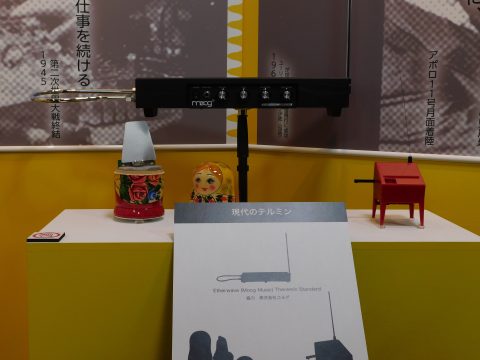
③ Electronic musical instrument precious concert (Tokyo University of the Arts, Ueno Campus, Hall 6)
* December 6 (Friday) Open 17:45 Start 18: 30-20: 30
Electronic music by performers from Tokyo University of the Arts and an ensemble of world-class thereminists.
“Ond Martono” is a precious instrument that is said to be the original synthesizer.
You can listen to a precious electronic musical instrument concert in a special woody acoustic space inside Tokyo University of the Arts.
A number of modular synthesizers that are rare in the world will be represented.
It is a nice project for electronic musical instrument fans.
Appearance:
[Part 1] Tokyo University of the Arts Hideshi Goto (Associate Professor, Department of Music Environment Creation), Kiyoshi Mitsuru (PhD Music Music Creation), Admiral Yuan (Master of Music Sound Creation), Toshiya Suzuki (Recorder)
[Part 2] Masami Takeuchi (Thermin), Mable and Da (Matryomin Ensemble), Motoko Oya (Ondo Martono), Yuko Yasuda (Piano)
④ “Osam and Musashi” screening (National Museum of Science, Japan Pavilion, 2nd floor auditorium)
* December 14 (Sat)
1st Open at 10:00 Screening at 10:30
2nd Open at 12:00 Screening at 12:30
3rd 14:00 Opening 14:30 Screening
4th screening at 16:00 and screening at 16:30
A one-day screening of the masterpiece animation “Osam and Musashi” by collaboration between Tezuka Productions and the musician Isao.
Please enjoy the video that can only be seen at the Tezuka Osamu Memorial Museum in Takarazuka City at the National Science Museum.
⑤ “Osam and Musashi” Special Talk Session (National Museum of Science, Japan Pavilion, 2nd floor auditorium)
* December 14 (Sat)
Open 17:30 Start 18:00 (Approximately 90 minutes including animation screening)
Tezuka Productions and musician Isao Hamada collaborates with this special program where three specialists “Osam and Musashi” talk about their work.
Performers: Akira Senju (musician), Satoshi Tezuka (visualist), Shinichi Fukuoka (biologist)
There are many other events, so please check the official website.
Equipment outline
| ■ Venue: National Museum of Nature and Science (Ueno Park, Tokyo), etc. |
| ■ Period: December 3, 2019 (Tuesday) to December 15, 2019 (Sunday) |
| ■ Opening hours: 9am-5pm (until 8pm on Friday and Saturday) * Admission until 30 minutes before each closing time |
| ■ Closed: Monday, December 9 * Opening hours and closed days are subject to change. Please check the official website ( https://www.kahaku.go.jp/english/ ) |
| ■ Price: You can see it only with the permanent exhibition entrance fee of the museum. General / University students: 630 yen (Group: 510 yen) High school students and younger and 65 years old and over: Free |
Article Provided by:Kokosil Ueno
See other exhibition information
【Tokyo Metropolitan Art Museum】 “A Look to the Children” + Chikara Matsumoto “Remember the Memorandum” Report Preview Report
Tokyo Metropolitan Art Museum
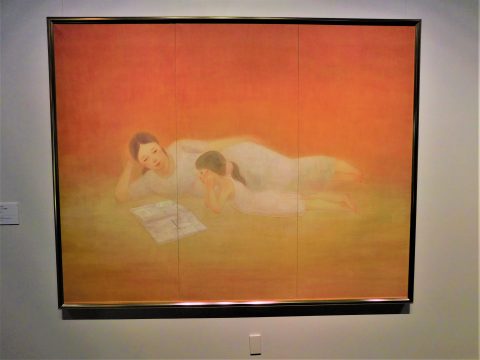
A Mother and Child’s Story 2013
From November 16, 2019 (Sat) to January 5, 2020 (Sun), at the Tokyo Metropolitan Art Museum in Ueno , the Ueno Artist Project 2019 “A Look to the Children” and Riki Matsumoto “Remember Memories” It is held.
The other day there was a joint press preview of these exhibitions, so I will report on the situation.
The highlights, composition, and featured works of each exhibition are featured.
What is “a look toward children”?
The Tokyo Metropolitan Art Museum is popular as a place for the presentation of works by many publicly-recruited organizations, and is called the “Hometown of Public-Exhibited Exhibitions”.
From 2017, the “Ueno Artist Project” series, which introduces contemporary artists who are active in open recruitment groups, has decided the theme every year.
This year, the third edition, will be held under the theme of “A look toward children”.
Introducing a multi-layered image that is temporarily entrusted to children drawn through the works of six artists from young to veterans who are currently affiliated with art recruitment organizations.
Composition and featured works
The “Gaze to the Child” is roughly divided into 3 chapters.
Chapter 1 Being Beloved
Chapter 1 introduces the works of Shinsei Kana (Japan Art Academy) and Ayako Okubo (Ichiyokai) on the theme of beloved beings.
・ SHINJO Kana
Shina Kana draws a delicate human figure with a soft touch using warm colors and a female motif.
The work exhibited this time is a pure girl image that does not know the world’s dirt, and a warm mother and child image that touches an important part of the heart.
Through the existence of children and mothers and children, the rebirth that wants to draw the preciousness, beauty, and love of life is re-recognizing the kindness that I received from my surroundings when I was a child. Says.
(Comments from newborn)
“ I want to express the inside of a girl spreading like a universe, and I’m drawing a work”.

・ Ayako Okubo
Ayako Okubo, an artist who consistently draws mother-child images.
The work exhibited this time is a mother-child image that gives a sense of the dynamics of moving children and a sense of unity between mother and child.
A large and generous mother gently wraps the babies and energetic children that are to be protected like the earth.
(Comment by Okubo)
With the theme of “spin life”, I have been making works for the last 10 years.
I hope I can express the energy of life through the children who fly around. “

Chapter 2 Growth and Conflict
Chapter 2 introduces the works of Tsubasa Shida (Independent Art Association) and Megumi Toyozawa (New Production Association) on the theme of growth and conflict.
・ Shida Tsubasa
While teaching at high school, Tsubasa Shida keeps drawing on the motif of modern junior and senior high school students.
The works on display this time are self-portraits depicting the inner faces of pure children who are looking at the inside of the aggression while struggling with the society created by adults, as well as the inner faces of society.
Unleash the real situation faced by today’s adolescent children.
(Comment by Shida)
“I want to express my child’s various psychology with my own paintings and connect with various people.”
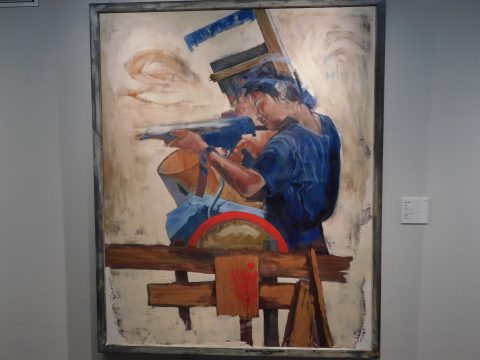
・ Toyosawa Megumi
Megumi Toyosawa keeps drawing high school girls who have projected themselves in the work.
Toyosawa draws about the feelings that she had in her adolescence that she wanted to deny herself, and that she continued to shake because of the influence of her surroundings.
It expresses the aching pains of the youth’s heart and evokes the emotions of the past that would have been felt when you were young.
(Comment by Toyosawa)
“There was a time when I made my work into a mold, but I reset it once to break that manner, and I drew the work with new feelings. I’m making ingenuity, so please enjoy it too. “
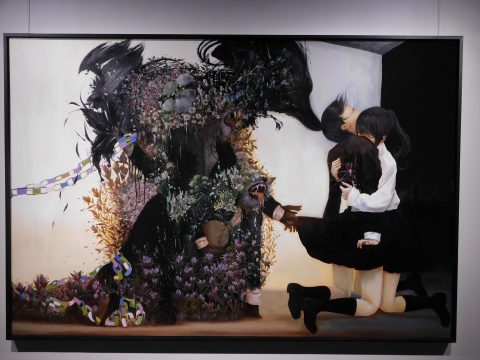
Chapter 3 Life Connection
Chapter 3 introduces the works of Akihisa Yamamoto (Main Art Association) and Masanori Kihara (Nikikai) on the theme of life’s connection.
・ Yamamoto Yasuhisa
We are the modern people who are covered with materials and information and want to destroy nature, but humans cannot live without symbiosis with nature.
Akihisa Yamamoto who continues to draw works as an antithesis to such a modern age.
The work exhibited this time is a human symposium centered on children and families who spend a calm time in abundant nature.
By touching the work, you should sympathize with the fundamental memory of human life.
(Comment from Mr. Yamamoto)
“I have consistently drawn works on the theme of abundance. This time I received the theme of an eye for children and made a new work based on that theme.
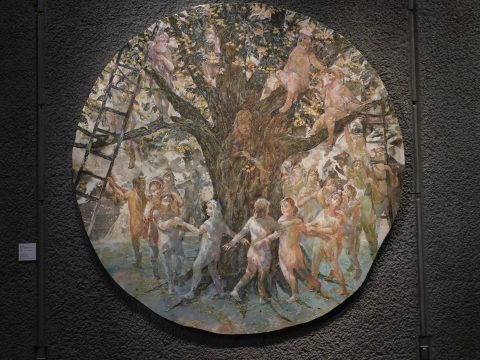
・ KIHARA Masanori
Masanori Kihara continues to draw a world in which the changing nature and the original nature of human beings with a rich sense of mass are intertwined.
The work on display this time is a world where nature and humans coexist without any boundaries and life circulates.
Using a unique color sensation and a sense of rhythm, we create a screen that is glossy and transparent, and asks viewers about the true richness.
(Comment by Kihara)
“I don’t draw the children directly, but through the richness of the colors, I’m making a work that I want to entrust with my life. Is an ugly work of my father who died two years ago.
My father passed away and my son and his wife had children, but through this work, it is a work that symbolically shows that life returns to the earth and a new life is born. “

Held at the same time Chikara Matsumoto “Remembering the Record”-Focusing on the Tokyo Metropolitan Museum of Photography
As a joint project with the “Look for Children”, Chikara Matsumoto “Remember Me” is held at the same time.
・ Matsumoto Chikara
Matsumoto Chikara (1967 ~) is an artist who is active both in Japan and abroad as a painter / animation artist.
Draw drawings one frame at a time, without tracing, and produce video works by adding transmitted light to shoot video.
As video installations, three-dimensional works, live performances using audio, and original workshops using hand-made video equipment are held in schools, museums, and areas where you stay.
This exhibition will show you the works held at the Tokyo Metropolitan Museum of Photography along with a new installation.
Composition and exhibits
Introducing the composition of the exhibition and the exhibits.
■ Six installation animation works
At the venue, six installation animations will be projected on the screen.
Six independent films will be screened one by one.
The 6 titles are as follows.
① A day on Mount Owari
② Electric Snow
③Follow Me / Meeting Beauty / Gaze
④ Calm warm
⑤ Singing voice across the mountain
⑥ To the mountain
(About the work)
The story of Oiwari from one day to the mountain is being developed with connections.
In the middle of the venue is a pyramid lookout.
Climbing to this vantage point, watching the video of the day of Mt. Owari over the mountain, it is made to be aware that the viewpoint will change and the field of view will change.
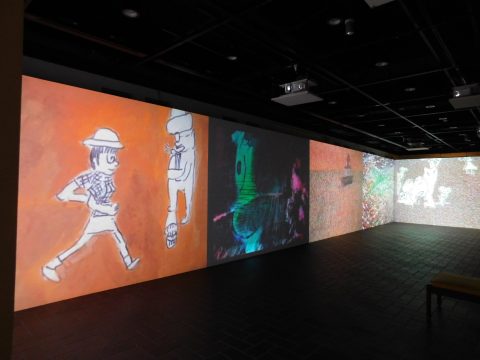
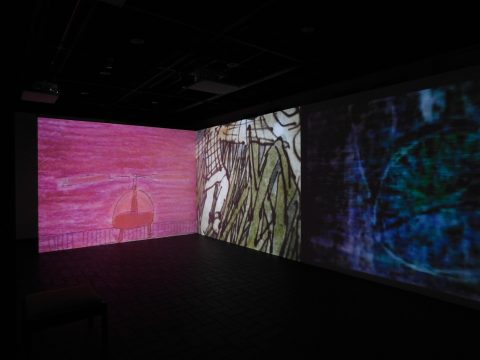

There are also 6 original installation works and multiple totem pole videos.
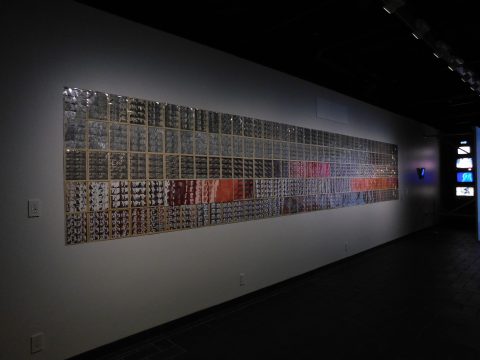
The video work SA YONA RA is also being screened.
This work is based on a picture of a continuation of an incomplete picture book written by Matsumoto-san’s dead father, with only one page left unwritten.
The character depicted in the work has a motif of an inexperienced person who doesn’t know anything about ghosts.
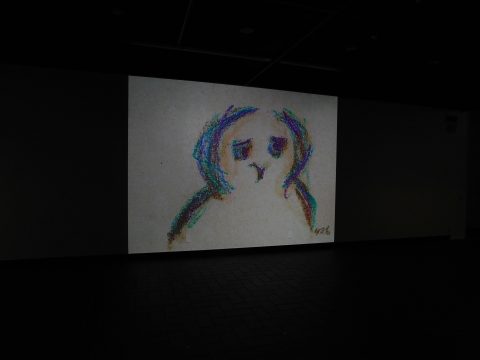
A cinema-type device has also been installed so that you can watch videos with different versions of SAYONARA’s music on headphones.
Please enjoy it freely.

Summary
I have reported the report preview report of “A look to the children” + Tsutomu Matsumoto “Remembering”.
In “A look at children”, I was able to touch on the memories of childhood that apply to me, the days when I was shining in adolescence, and the fundamental questions of life.
In Matsumoto Tsutomu’s “Remember Memories”, I was able to confirm myself in a nostalgic day of childhood that makes me feel a little sad and sad.
Why do not you come to look for your past memories and hope for the future through these two exhibitions?
We are waiting for you at the Tokyo Metropolitan Art Museum.
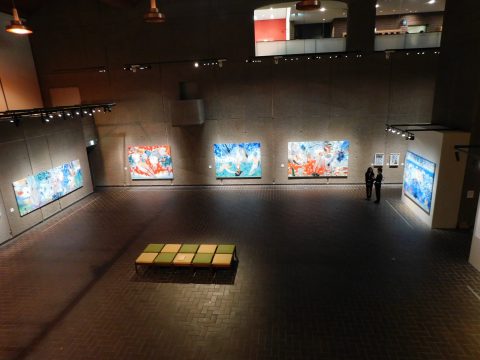
Outline
Ueno Artist Project 2019 “ Gaze to the Children ”
| ■ Date: November 16, 2019 (Sat)-January 5, 2020 (Sun) |
| ■ Venue: Tokyo Metropolitan Art Museum Gallery A ・ C |
| ■ Opening hours: 9: 30-17: 30 (Last entry 30 minutes before closing) |
| ■ Opening at night: Friday, November 30 (Saturday), December 7 (Sat) 9: 30-20: 00 (Last entry 30 minutes before closing) |
| ■ Closed days: November 18 (Monday), December 2 (Monday), 16th (Mon), 26th (Thurs)-3rd 2020 (Fri) |
| ■ Admission fee: Same-day tickets: General 500 yen / 65 years old and over 300 yen Group ticket: General 400 yen * Group discounts for 20 people or more * Free for students and younger * Free for those with physical disability certificate, love certificate, nursing certificate, mental health care welfare certificate, and A-bomb victim health certificate (up to 1 person) * Please bring something that you can prove. * “Coultrede Museum Exhibition fascinating impressionist” held at the same time Admission is free by presenting a ticket (stub) |
| ■ Organizer: Tokyo Metropolitan Foundation for History and Culture, Tokyo Metropolitan Art Museum |
| ■ Contact: Tokyo Metropolitan Art Museum TEL: 03-3823-6921 (representative) |
| ■ Event information: Please check the Tokyo Metropolitan Art Museum website “Gaze to the Children” page. https://www.tobikan.jp/en/exhibition/2019_uenoartistproject.html |
Tsutomu Matsumoto “Remembering the Record”-Focusing on the Tokyo Metropolitan Museum of Photography
| ■ Date: November 16, 2019 (Sat)-January 5, 2020 (Sun) |
| ■ Venue: Tokyo Metropolitan Art Museum Gallery B |
| ■ Opening hours: 9: 30-17: 30 (Last entry 30 minutes before closing) |
| ■ Opening at night: Friday, November 30th (Saturday), December 7 (Sat) 9: 30-20: 00 (Last entry 30 minutes before closing) |
| ■ Closed days: November 18 (Monday), December 2 (Monday), 16th (Mon), 26th (Thurs)-3rd January 2020 (Fri) |
| ■ Admission fee: Free |
| ■ Organizer: Tokyo Metropolitan Government, Tokyo Metropolitan Foundation for History and Culture, Tokyo Metropolitan Art Museum |
| ■ Contact: Tokyo Metropolitan Art Museum, Exchange TEL: 03-3823-6921 (Representative) |
| ■ Event Information: Tokyo Metropolitan Art Museum HP Riki Matsumoto Please check the page. https://www.tobikan.jp/en/exhibition/2019_collection.html |
Article Provided by:Kokosil Ueno
【The National Museum of Western Art】 Hapsburg Exhibition Press Report
The National Museum of Western Art
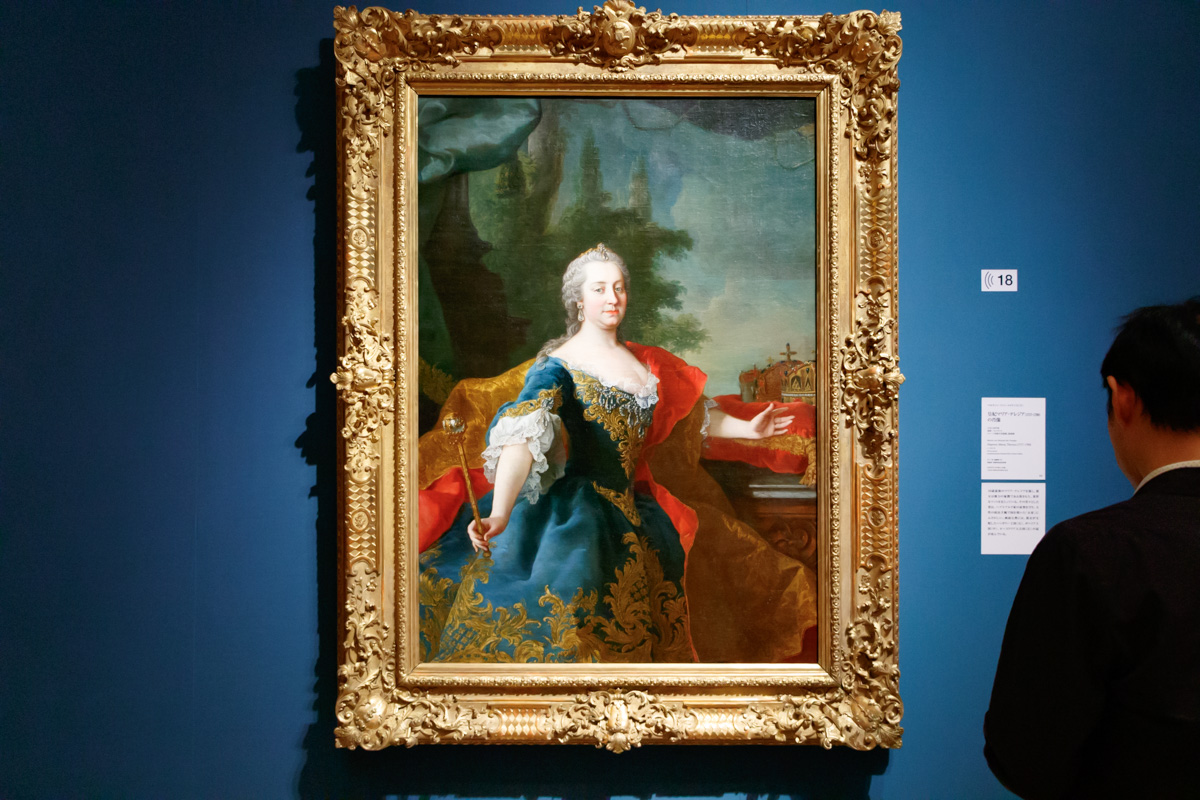
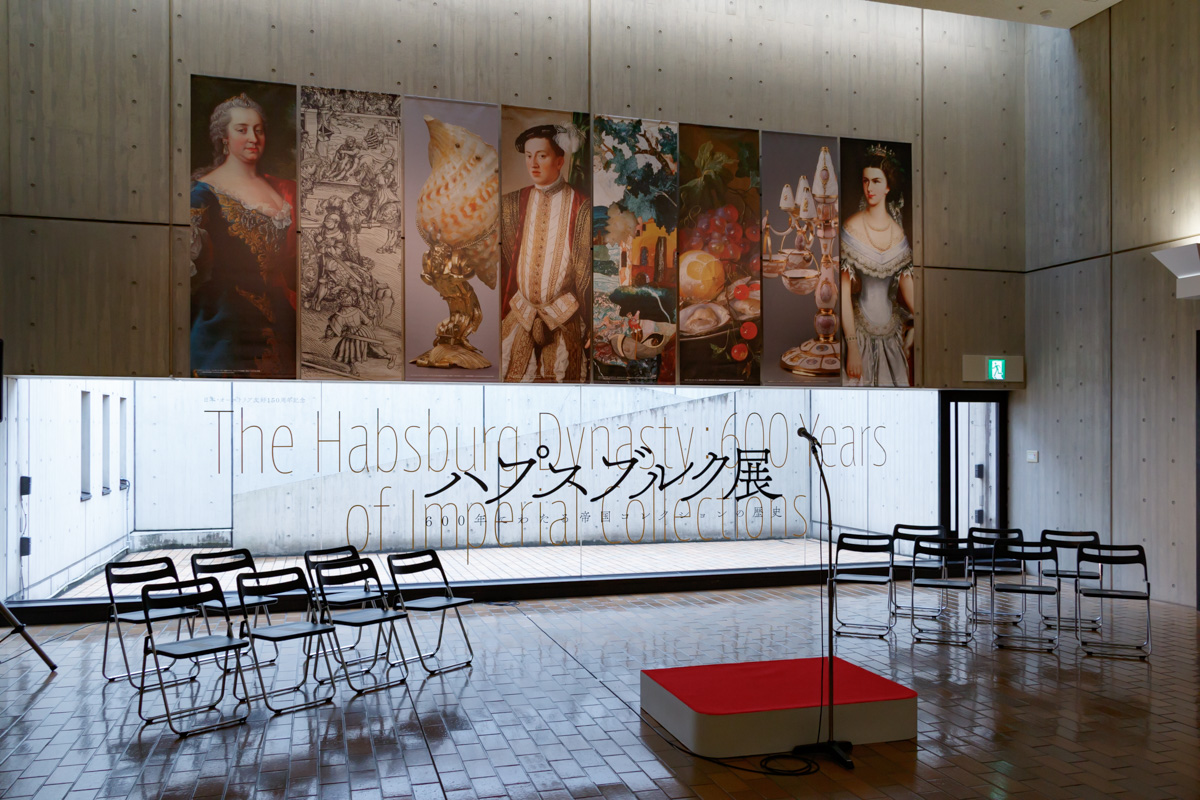
From October 19th (Sat), 2019, at the National Museum of Western Art, Tokyo Ueno,
The 150th anniversary of the friendship between Japan and Austria, “Hapsburg Exhibition: 600 Years of Imperial Collection History” is held. (Until January 26, 2020)
The other day, prior to the event, a press preview was held.
About the Habsburg family
The Hapsburg family emerged as an Australian in the upper reaches of the Rhine, and expanded to Austria at the end of the 13th century.
One of Europe’s most prestigious families, who ruled a wide range of empires over hundreds of years until the end of World War I (1918).
Specifically, the Holy Roman Empire monopolized after the 15th century, and when the Habsburgs split into Austrian and Spanish in the 16th and 17th centuries, the Spanish expanded to South America, Africa and Asia.It became an empire without the sun setting.
After the dismantling of the Holy Roman Empire, triggered by the Napoleonic Wars, he later ruled the Austrian Empire.
During this long reign, he possessed treasures such as the world’s finest arts, decorations, crafts, weapons and historical memorabilia, utilizing his wealth and personal connections.
The “Hapsburg Exhibition” is an exhibition that introduces about 100 items, including paintings, weapons, crafts, tapestry, and prints, in cooperation with the Vienna Art History Museum, which was built by a family and opened in 1891.
Composition of the Hapsburg exhibition
The composition of the Hapsburg exhibition is as follows.
Chapter 1
The beginning of the Habsburg family collection
In Chapter 1, we will introduce 12 collections of paintings, armor, and crafts from the time when full-scale collection of the Hapsburg family art from the late XV to the 16th century began.
The attention of the Habsburgs in this period was Maximilian I (1459-1519).
Famous for his skillful marriage and expansion of his territory, Maximilian himself married Marie’s successor Marie, Flemish Burgundy, and created an opportunity to enrich the Habsburg family collection.
Chapter 2
Rudolf II and Prague Palace
Chapter 2 extends on Holy Roman Empire Rudolf II (1853-1612), a famous collector, and introduces 30 items including tapestry, armor, paintings, and sculptures.
Rudolf had no sense of governance, but the depth of art and academic knowledge was extraordinary, and when he moved the court from Vienna to Prague in 1583, paintings, weapons, small sculptures and crafts, Owned a diverse collection of natural objects specimens and watches .
Chapter 3
Chapter 3 is divided into three sections.
Chapter 3 1 The Spanish Habsburgs and Leopold I
In Chapter 3, section 1, we will introduce seven collections, including portraits that became a tool of the era when the Habsburgs were split into two systems of Austrian and Spanish and kept in touch.
The center of this era is King Philip IV of Spain (1602-1644).
He was young and thriving, passionate about art and culture, hired young Velázquez as a court painter and treated him.
Chapter 3-2
Ferdinand Carl and Tirol collection
Chapter 3-2 introduces six paintings including a collection of Ferdinand Karl, one of the Grand Duchy of Austria and an important collector, belonging to the Habsburg family.
Chapter 3-3
Chapter 3-3 introduces 24 paintings, including the collection of Leopold Wilhelm (1614–1662), one of the most important collectors of the Habsburg family.
Chapter 4 The Habsburgs and Imperial Gallery in the 18th Century
Chapter 4 introduces the people of the Habsburgs who survived the turbulent 18th century in a collection of 15 items, mainly portraits.
The attention of this era was Maria Theresia (1717-1780).
She is the “emtress” who showed her natural wisdom, political skills, and led the people through national difficulties.
Another note is Marie Antoinette (1755-1793), the youngest daughter of Maria Theresia.Married to the later French king Louis XVI, but the queen of Guillotine disappeared in the French Revolution.
Chapter 4 revolves around these people.
Chapter 5 The long reign of Franz Josef I and the end of the Austrian-Hungarian double empire
The New Holy Roman Empire was dismantled after the Napoleonic Wars, and the Austrian Empire was born in 1804. (From 1867, Austria = Hungary Double Empire)
However, the Austrian Empire collapsed due to the defeat of World War I. At the same time, the Habsburgs will end.
Chapter 5 introduces six works related to Franz Josef I (1830-1916), who decorated the endless beauty as the actual last emperor of the Habsburg family.
Editorial department attention work
Margarita Teresa, Princess of Blue Dress
Margarita Teresa’s latest work by Velázquez depicting the age of 8.
Wearing a gorgeous silk blue dress and looking at you with straight eyes, this figure is so calm that you can’t imagine it was eight years old.
Velázquez also describes Margarita Teresa, 3 and 5 years old.

Portrait of Princess Maria Theresia
A portrait of Theresia, drawn by Martin van Metens, a child who was heavily used in the early reign of Maria Theresia.
From the work, you can feel the confident expression of “The Emperor” Maria Theresia who led the people and the openness of 16 children.

Portrait of French Queen Marie Antoinette
A work by Marie-Louise Elisabeth Vigere-LeBlanc, who was used by Marie Antoinette as a court painter.
The work depicts a young Marie Antoinette who was married to France in a political marriage.
Marie Antoinette wearing a gorgeous satin dress and a pink rose flower is shining, and from this work you can’t even imagine a tragic death in the French Revolution.
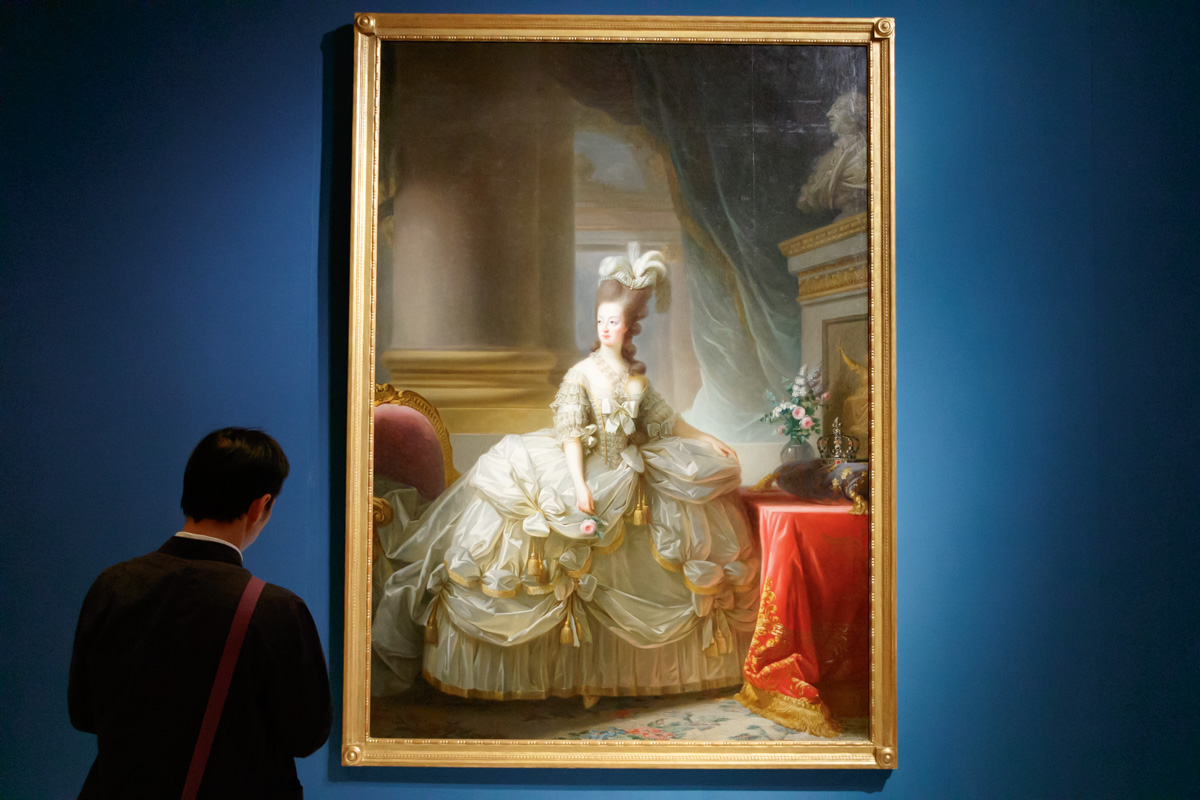
Elizabeth in a pale blue dress
Portrait of Josef Horacek, depicting Elizat (nicknamed Sissi), the wife of the Austrian Emperor, who was spotted by the Hapsburg family’s last imperial emperor Franz Josef I. Because of her death, she seems to be sucked into her aura who was later deified .
The story of Elizabeth wearing a corset and imposing dietary restrictions on a daily basis to maintain the system is famous.

Rebeka and Eliezer at the well end
This is a masterpiece of Ottavio Vannini, depicting a scene related to the marriage of Isaac and Rebekah in the Old Testament.In the middle of the painting, Rebeka is pouring water on the reeds of his follower Eliezer and the camel behind it And the women who hold the meeting at the well end are also drawn lively.

Virgin and Child
A work depicting the infant Christ standing on the lap of the Virgin Mary.
The expression of Christ’s limbs that stand up in balance is delicately depicted.And the expression of Virgin Mary, who supports Christ, is calm and still seems to spill.

Holy Roman Emperor Leopold I (1640-1705) and Princess Margarita Teresa (1651-1673)
This painting was drawn by Jan Thomas, one of the most important painters during the celebration of the Imperial Palace of the Holy Roman Emperor Leopold I (1640-1705) and Margarita Teresa (1651-1673).
At the banquet, people dressed in costumes for the costume party enjoy the party with the emperor and his wife sitting in the back left.
If you listen carefully, you will hear the cheers of the banquet and you will feel like you are participating in the party.

Summary
We have reported on a press preview of the “Hapsburg Exhibition 150 Years of Friendship between Japan and Austria”
Many people attended the venue, not to miss one of the 100 collections of the Hapsburg family.Some of them spent several tens of minutes on the work.There were also women who were eager to watch without being able to leave, and women who wore costumes reminiscent of Marie Antoinette.
All the works at the venue are gorgeous for the royal collection.
In addition to the works introduced, there are countless exhibits such as paintings, weapons, crafts, tapestry and prints.
Currently held “Histsburg 150th Anniversary of Japan-Austria Friendship History of Empire Collection over 600 years”.
Please come to see the gorgeous items at the National Museum of Western Art.
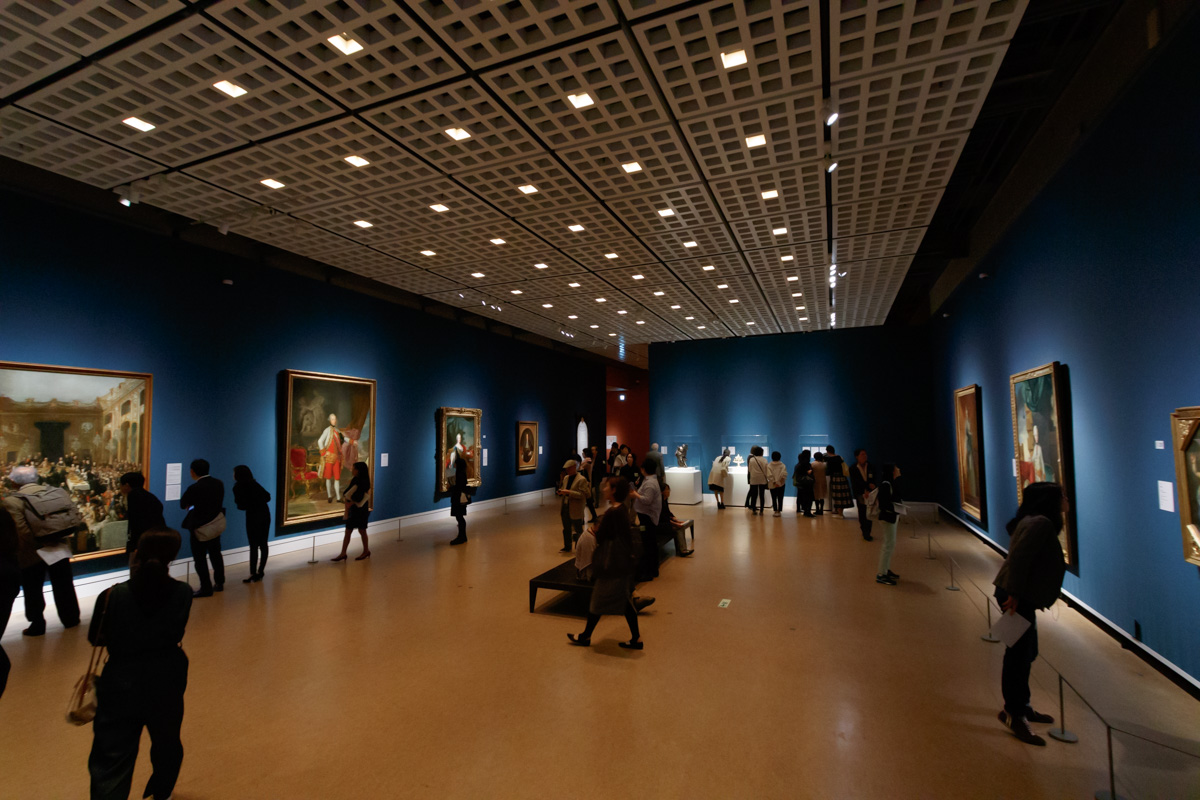
Outline
| Exhibition name | 150 Years Friendship Austria – Japan “The Habsburg Dynasty: 600 Years of Imperial Collections” |
| Dates | October 19, 2019 (Sat) -January 26, 2020 (Sun) |
| Venue | The National Museum of Western Art (Ueno Park, Tokyo) |
| Opening hours | 9: 30-17: 30 (Friday and Saturday until 20:00. November 30 (Saturday) until 17:30) * Admission is 30 minutes before closing |
| Closed | Every Monday (but open on November 4 (Monday / holiday), January 13 (Monday / holiday)), November 5 (Tue), December 28 (Sat) -January 1 Sunday (Wednesday / Holiday), January 14 ( Tue) |
| Admission fee | (on the day) General 1,700 yen University student 1,100 yen High school student 700 yen (Advance / Group) General 1,400 yen University student 1,000 yen High school student 600 yen * Group fee is 20 people or more. * Free for junior high school students and younger. * Free for the physically and mentally handicapped and one accompanying person (please present the handicapped person’s handbook when entering the building). |
| Official website | https://habsburg2019.jp/en/#/ |
【National Museum of Nature and Science】 Special supporter Takeshi Takeshi also appears! Special Exhibition “Mummy In Search of Eternal Life” Preview Report
National Museum of Nature and Science
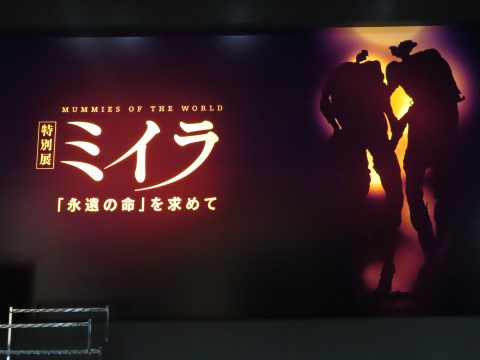
From November 2, 2019 (Saturday) to February 24, 2020 (Monday, National Holiday), the National Museum of Nature and Science is holding a special exhibition “In Search of Eternal Life” . I participated in a media preview, and this time I will tell you about it!
The largest in Japan! "Science" mummy exhibition
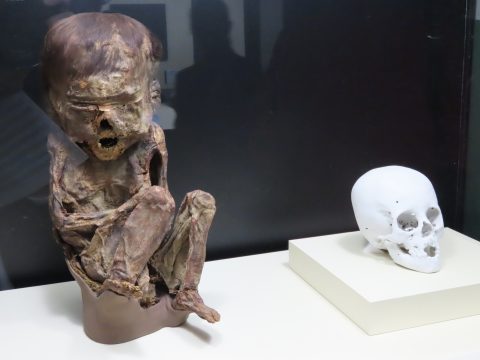


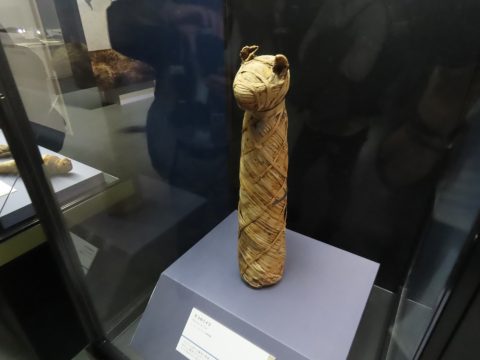
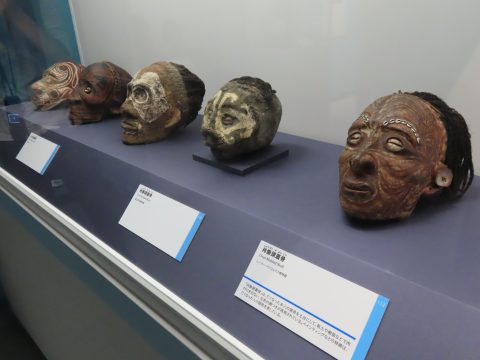
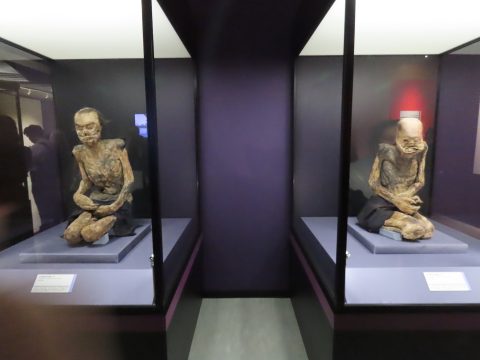
"Scared" "Uncomfortable" … Some people might look at the mummy and grin unexpectedly.
But at least many of the readers of this article have a fundamental “curiosity” beyond a certain interest, likes and dislikes about mummy.
Why did people make mummy? There is a deep connection with the environment surrounding the people who lived at that time, the view of life and death, and the view of religion.
Mummy has not attracted much academic interest for a long time due to its scarcity, but the information that can be extracted by the recent science and technology has increased dramatically, and the mummy has been re-investigated and the development of storage methods has been renewed. It is broken.
In this exhibition, we will explain the mummy from all over the world, various cultures and views of life and death, and the actual image of the mummy that has been revealed scientifically. South America, Egypt, Oceania, Japan … Through the 43 mummy gathered from all over the world, we introduce the various views of life and body that human beings have.
Mummy from all over the world gathers in “Kahaku”!
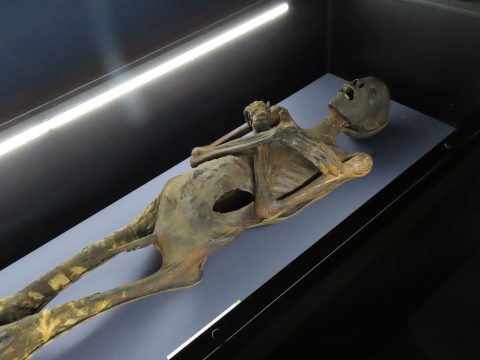
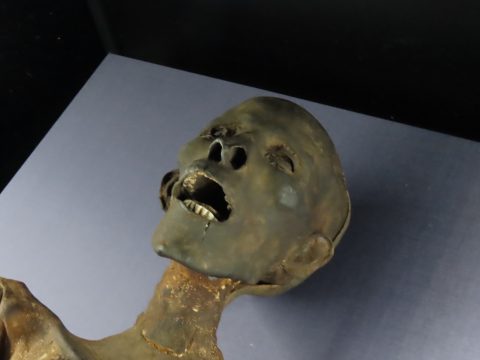
Mummy with genitals attached? !
Greco-Roman era, ruled by Gilshas and Romans. Even after the ancient Egyptian religion was considered heresy, mummies were made in a simpler way. This is a male mummy with a distinct pose that crosses arms, which has been a trend since the New Kingdom. The state of preservation is good, and if you look up close, you can feel the freshness of the facial expression.
According to a CT scan survey, this mummy is a 35-40 year old man. The brain is removed from the nose, the internal organs are removed by incising the left flank, and the body is filled with bags containing linen and natron. Characteristically, the male genitalia made of linen is attached, which is based on the myth of Osiris and is related to the concept of regeneration and resurrection.
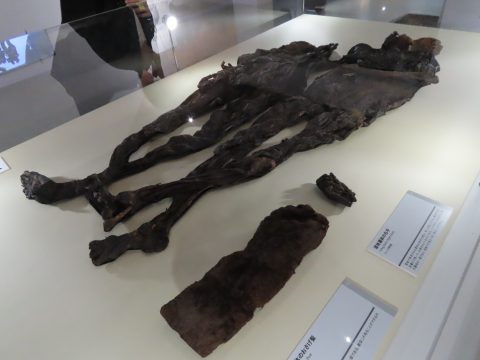

First public release in Japan! Mysterious two mummy
European culture has little custom of preserving bodies as mummies, and most of the discovered mummies are “natural mummies”. Here are two wetland bodies found in the Bortung Marshland in the Netherlands in 1904.
Two mummy that seems to hold hands. In an extreme state, I can imagine that it is a couple who died while staying close together, but it turns out that both are actually men. Unfortunately, it seems that the relationship between the two has not been elucidated due to poor DNA preservation, and there are still many mysteries.
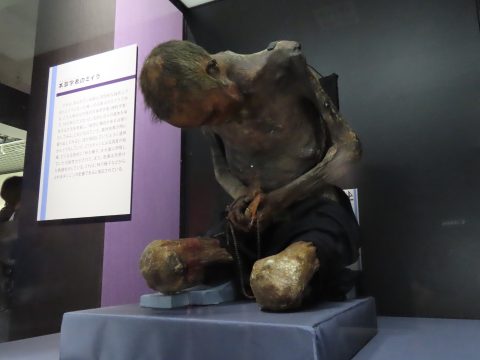
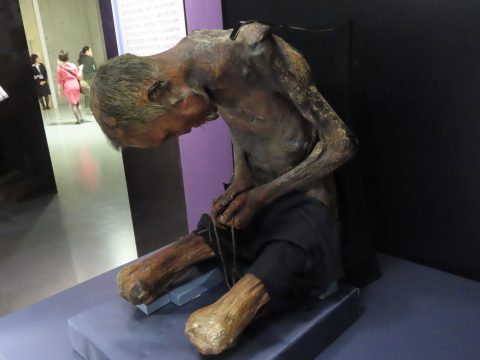
National scholar who made himself an “experimental table”
A Japanese mummy that keeps its original appearance from appearance, body shape and skin texture. This person is a herbologist of the Edo period (modern natural history and pharmacology). In order to confirm his research results, he devised a method for preserving his body and said, “If you have a chance in future generations, dig out.” It seems to have been told. In other words, you have become a mummy with your own will (!) From an academic pursuit.
The skin has a reddish brown color, but this may have been due to the effects of tannins in the seeds of cocoons because it was found that they had consumed a large amount of "seed seeds" just before their death. How did he succeed in mummyizing himself? Unfortunately, no specific method has been reported.
Special supporter Beat Takeshi also appears!
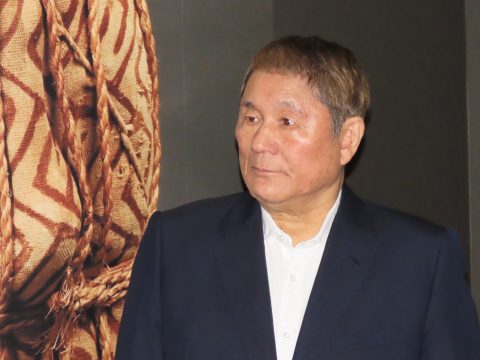
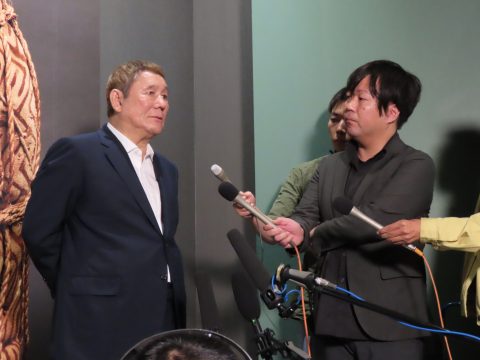
In addition, Beat Takeshi, a special supporter of this exhibition, also appeared at the preview. Takeshi who visited the exhibition hall with the curator
“When I became a mummy, I saw a mummy (the herbologist's mummy) and trembled. It ’s a great spiritual world. Is unknown and something that can't be done "
And enthusiastic about the cultural value of the mummy, which retains clues from the ancient times. In addition, he mentioned that there was an era of burning mummies in the past, appealed for the importance of spreading education that valued cultural heritage early,
“After all, I want the children to see it. It ’s important to be interested in something and want to know more. In the current era, there are searches such as Google, but the real thing is still photos No, there are strange gears. "
He talked about the significance of this exhibition.
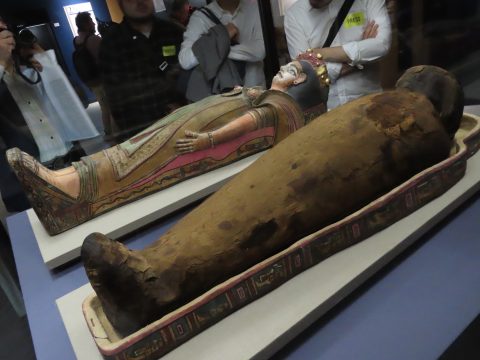
Real image of the mummy revealed by the latest science. Mummy is a “traveler from the past” that tells us the culture and history of people who lived in the past and various “feelings”.
“Mummy seeking for eternal life” will be held until February 24, 2020 (Monday / Holiday). Please come to the venue and listen to the words spoken by mummy from all ages and regions.
Outline
| Exhibition name | Special Exhibition “In Search of Eternal Life” |
| Session | From Saturday, November 2, 2019 to Monday, February 24, 2020 9am-5pm (Friday and Saturday until 8pm) Until November 3 (Sunday / Holiday) 8:00 pm November 4th (Mon / Close) Until 6pm * Admission until 30 minutes before each closing time |
| closing day | Monday (Tuesday if Monday is a public holiday) And December 28 (Sat)-January 1 (Wednesday / Holiday) However, it is open on February 17 (Monday) * Opening hours and closed days are subject to change. |
| Venue | National Museum of Nature and Science |
| Admission fee | General / university students Advance 1,500 yen On the day 1,700 yen Group Advance 500 yen 600 yen on the day ・ Free for preschoolers. Free for those who have a disability certificate and one caregiver. ・ This exhibition will not be available on Friday / Saturday limited pair tickets. ・ Persons viewing this exhibition with this ticket can also see permanent exhibitions (Ground Hall and Japan Hall) on the same day. |
| Official site | http://www.tbs.co.jp/miira2019/ |
2nd Edo Town Taito Performing Arts Festival ~ Summer Team ~
Beat Takeshi ~ Talking Asakusa ~ Experience Report
Taito Ward Asakusa Public Hall
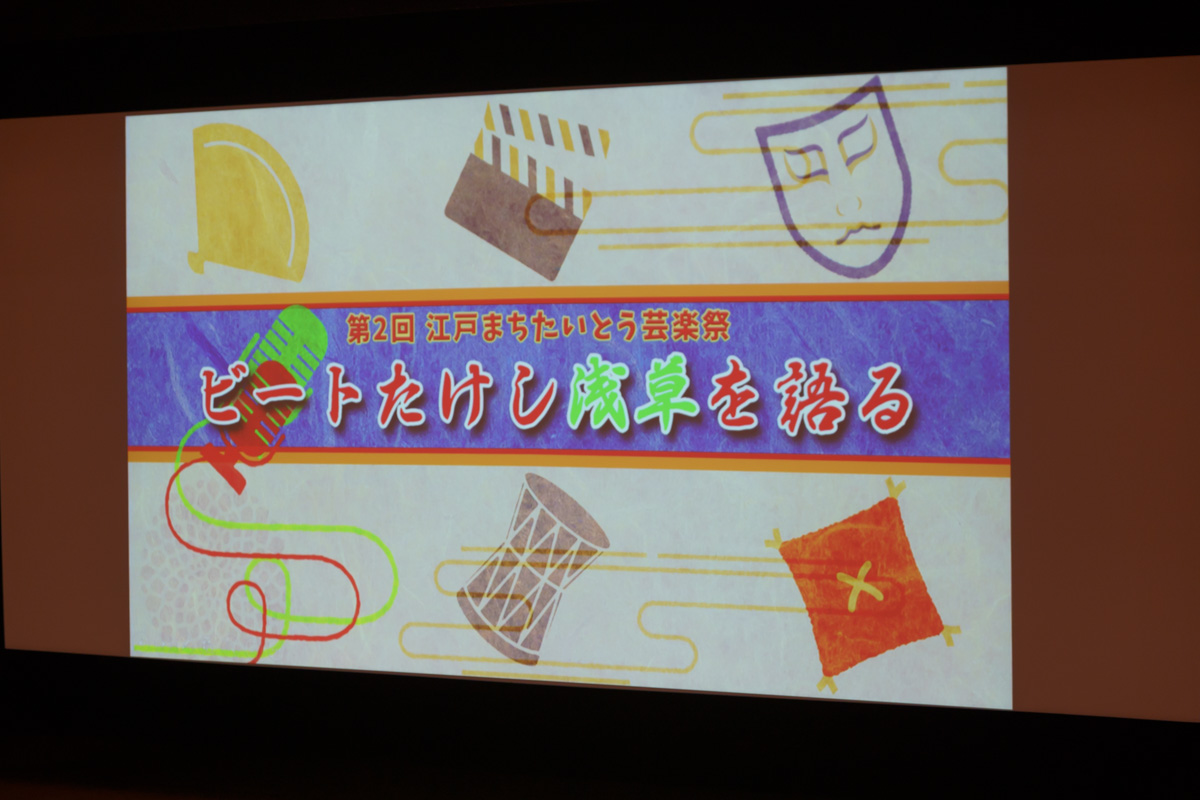
From August 18th (Sun) to October 26th (Saturday), the 2nd Edo Machitaito Geiraku Festival ~ Summer no Jin ~ is held. It is a festival where you can enjoy the various performing arts and art culture that have been nurtured, protected, and inherited to the present age, such as enterprising spirit.
On October 15th, “Beat Takeshi ~ Talking about Asakusa ~” was held.
This event was attended by Beat Takeshi, honorary adviser to the executive committee of the performing arts festival.
What does Takeshi talk about?
This time we interviewed you, so please have a look.
This event is part 1 in comics, comedy, Wandering song, rakugo,
In the second part, Takeshi’s talk show and two parts.
Part 1 Top Batter is Shooting Star who has won the THE MANZAI Takeshi Award for the second consecutive year of 2017 and 2018.
The audience’s grab is OK with the calmness of Chuei’s gag and Shinichiro Takiue, who intrudes into the audience seats and makes unexpected movements. I ended up.
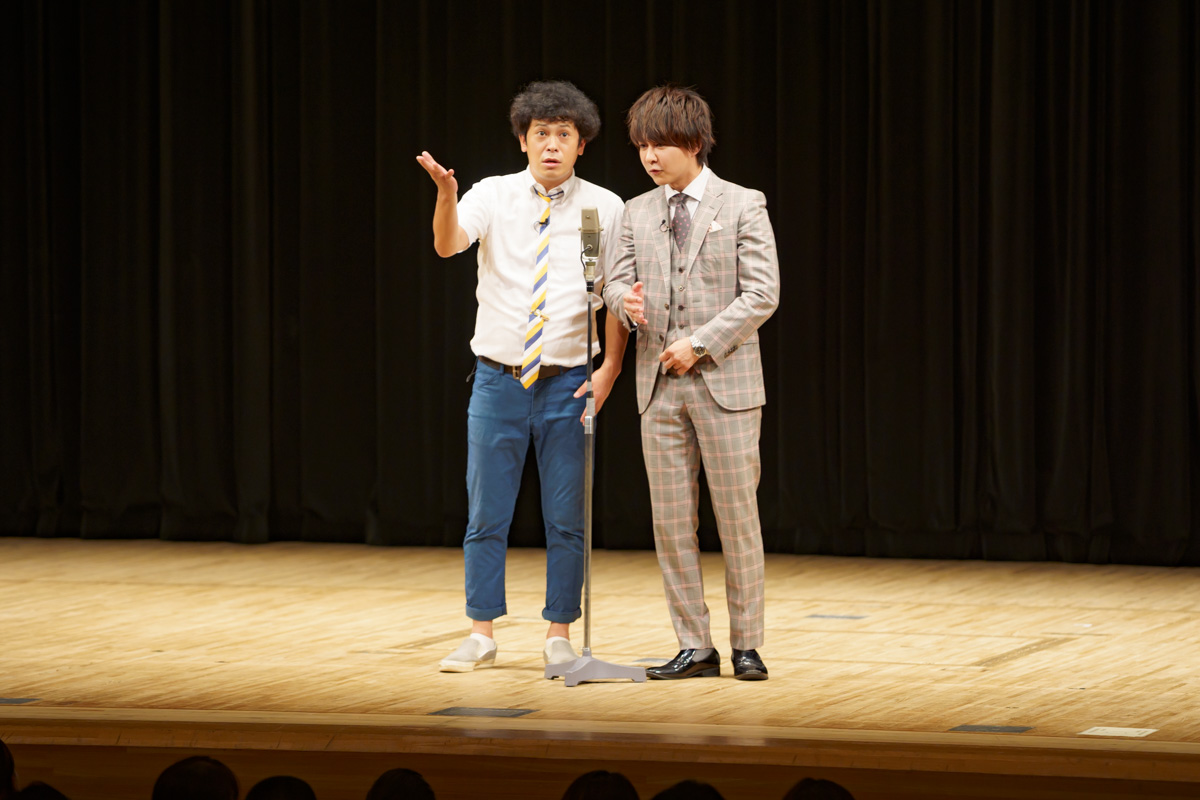
Next is the appearance of Hiroshi (Comedy), a pin entertainer who made a big break in 2004.
Mr. Hiroshi who is obsessed with his masochism.
The sad and humorous story is unrivaled.
The venue will be heated to every word.
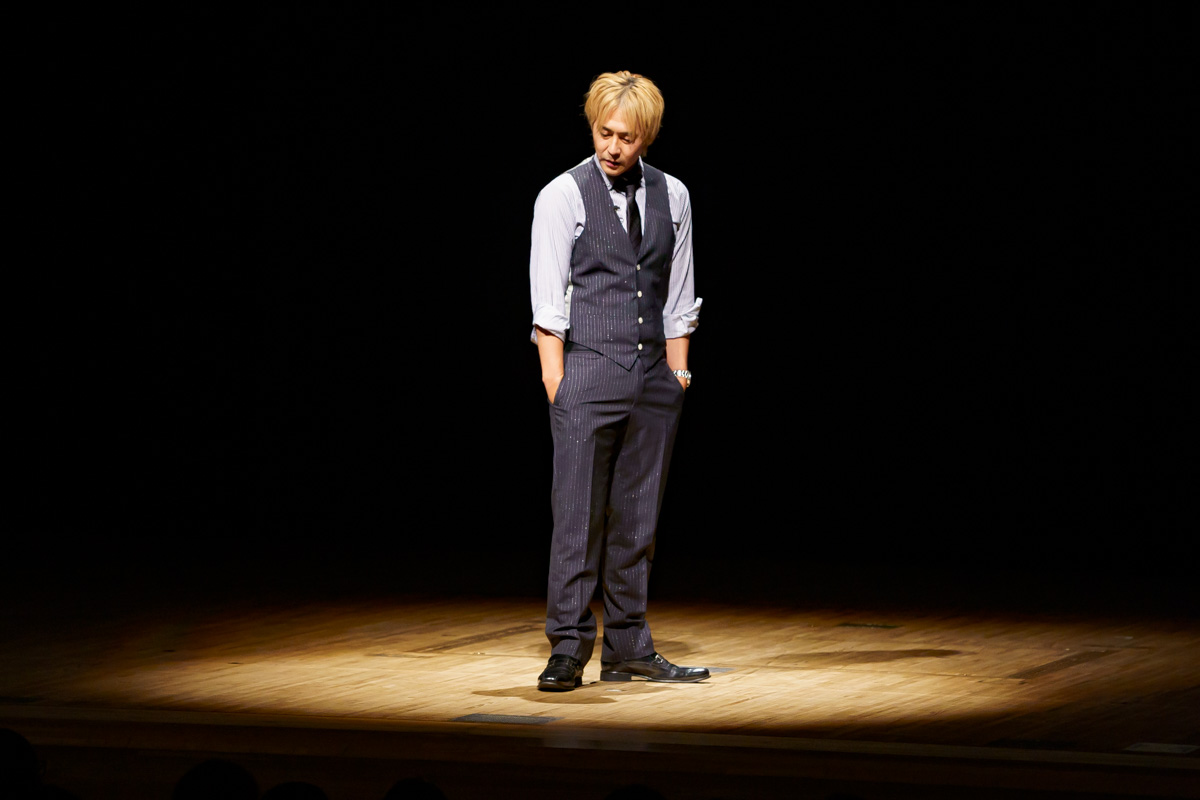
The third is Tamagawa Daifuku’s Wandering song.
When Daifuku went up on the stage, a loud shout “Daifu-ku!” Came from the venue.
After explaining to the customers how to enjoy and excite the Wandering song, they showed off the Wandering song that were arranged in a modern style. A sense of unity and applause wrapped up the venue.
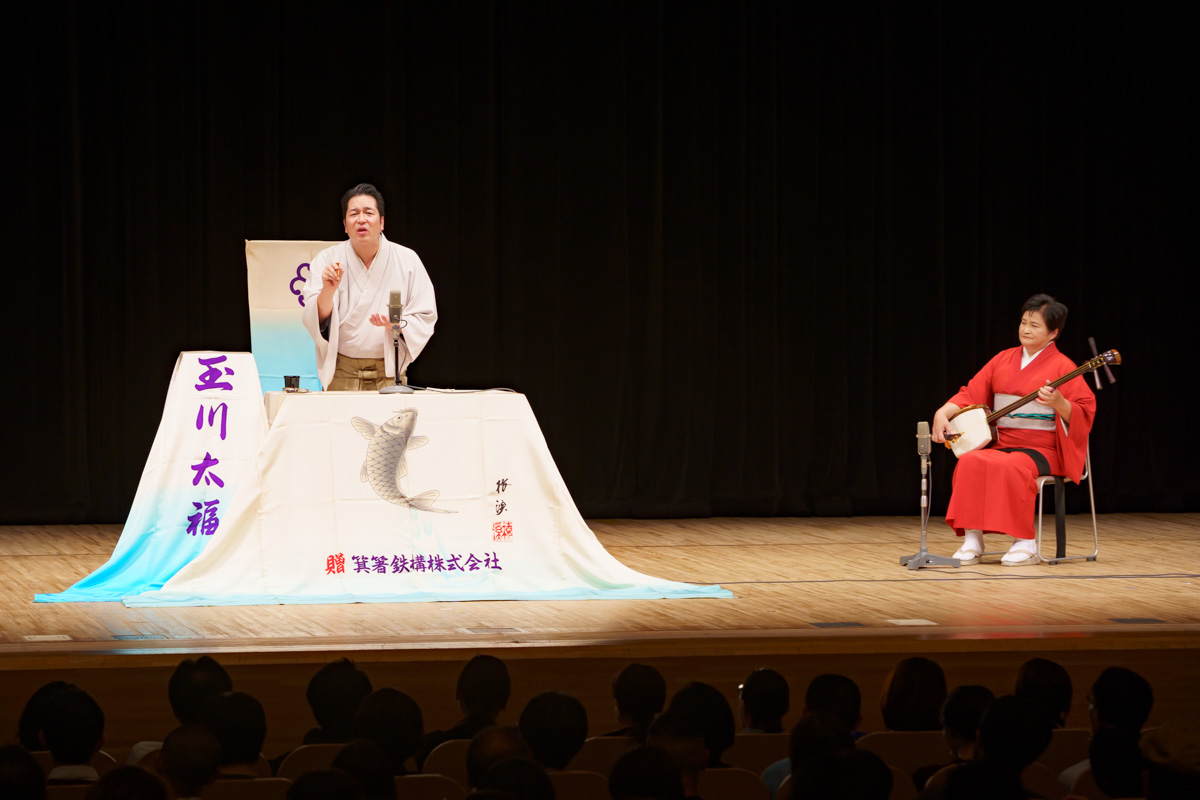
Lastly, it is a rakugo story of Kokontei Kikunojo.
After grabbing the heart of the customer with a sarcastic pillow, the classic rakugo “Turnover” was performed. The conversation between the drunk man and his wife was heard in sophisticated narratives. In the Taiga drama “Idaten”, Rakugo is being taught by Shinsho Kokontei and other actors that Takeshi plays.

Part 2
Finally, it ’s Beat Takeshi.
In the opening MC talk, Takeshi-san was recording a TV program and had not yet arrived at the venue, so the talk show itself was in danger, but in fact it was a story. Takeshi-san.
Asakusa has become familiar and has become an entertainer since his childhood. For the unique people he met in this area, he used his own Poisonous tongue and talked with his Attendant, Al Kitago, at a good pace. You
It was impressive that the customers continued to laugh at Takeshi-san’s unstoppable Poisonous tongue.


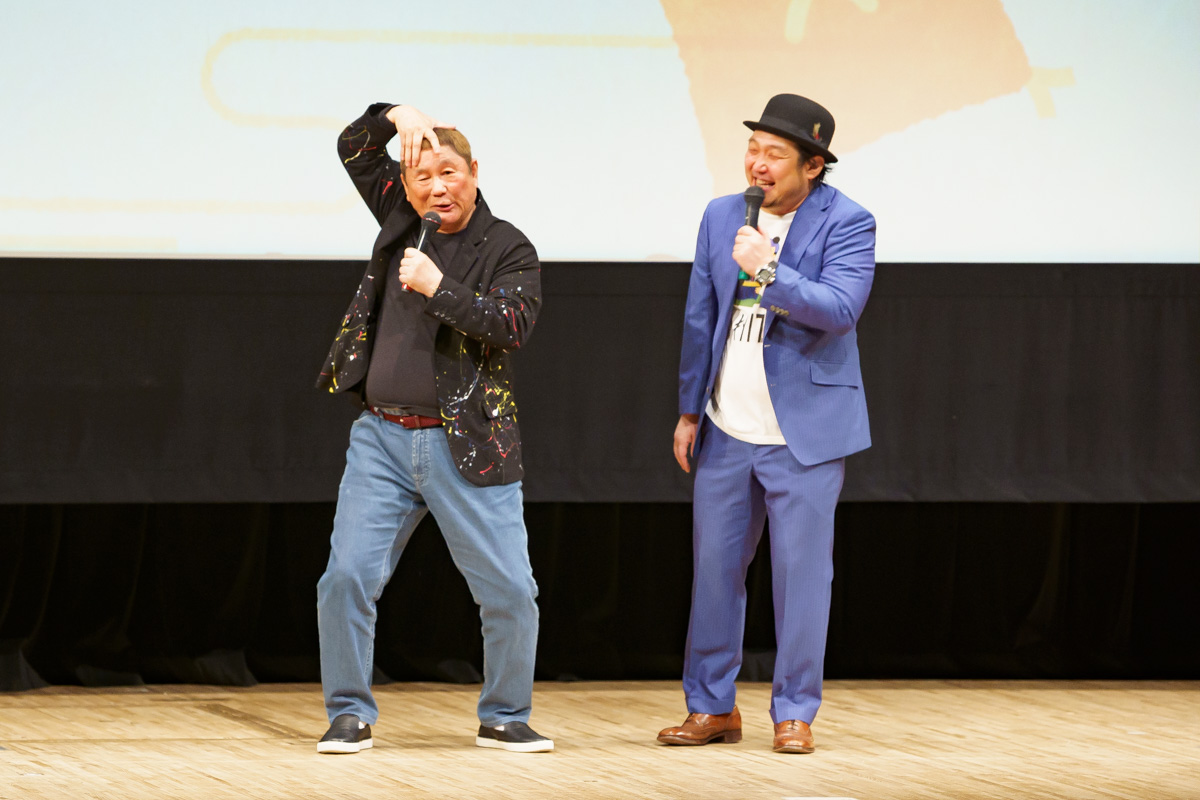
The ending gathered with Takeshi and the performers gathered on the stage.
Takeshi’s Poisonous tongue doesn’t stop there.
Both the customers and the performers were laughing at Mr.Takeshi’s good tempo.
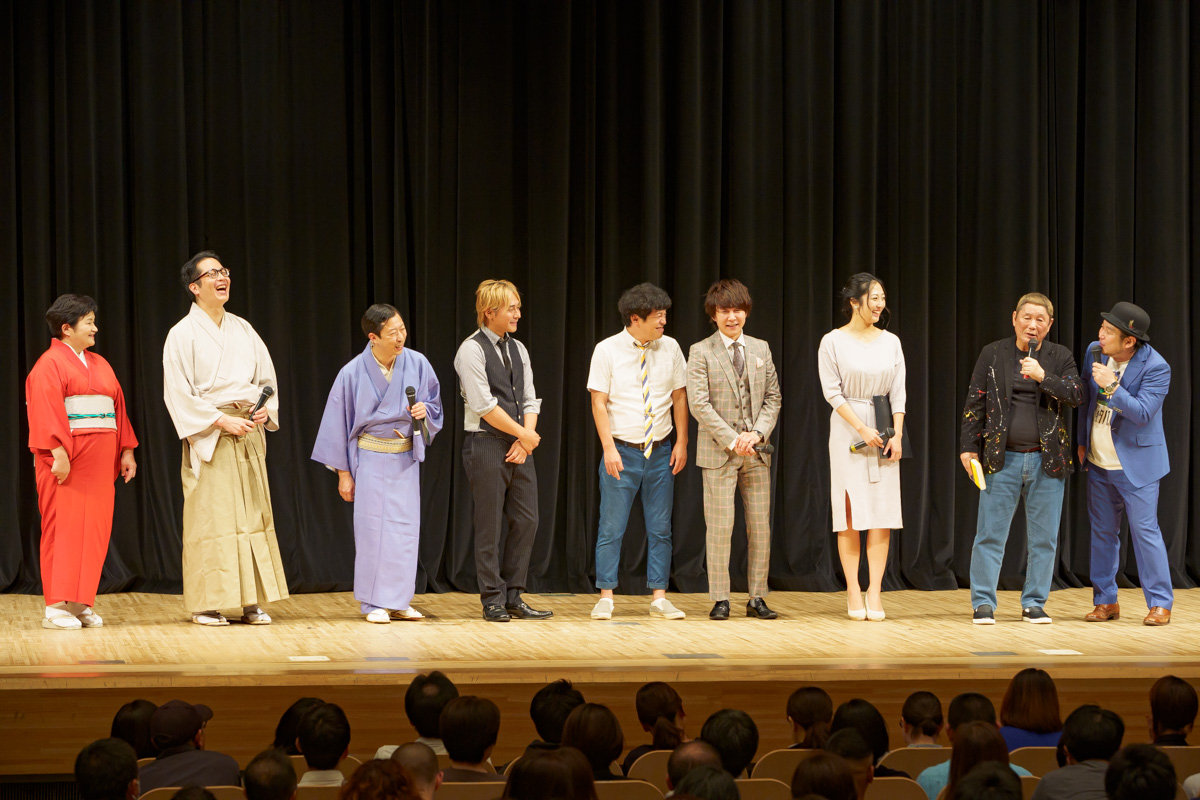
Summary
We reported on the experience report of the 2nd Edo Machi Taito Geiraku Festival-Summer Team-“Beat Takeshi-Talking about Asakusa”.
The laughter of stage performance created by both performers and customers, which cannot be felt on the TV screen, created a sense of unity throughout the venue and a fun time.
The summer team of the 2nd Edo Town Taito Geiraku Festival ended on Saturday, October 26, but the winter team will be held from January 2020, next year.
Edo-machi Taito Performing Arts Festival with a wide variety of events such as movies, performing arts, and theater. Keep an eye on the future.
Outline of Edo Town Taito Performing Arts Festival
| Session | August 18, 2019 (Sun)-February 15, 2020 (Sat) |
| Venue | ○ Ueno district Takenodai Plaza of Ueno Onshi Park (Fountain plaza) -Okachi the town south exit station square addition ○ Yanaka district disaster prevention Square Hatsune of forest ○ the Northern District of Sanya moat Square other ○ Southern District Kuramae elementary school ○ Asakusa district Higashi Honganji Temple, Taito Ward Asakusa Public Hall Other |
| Official website | http://www.taitogeirakusai.com/ |

